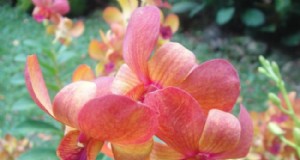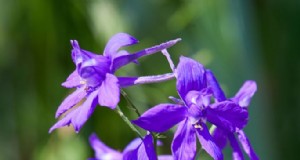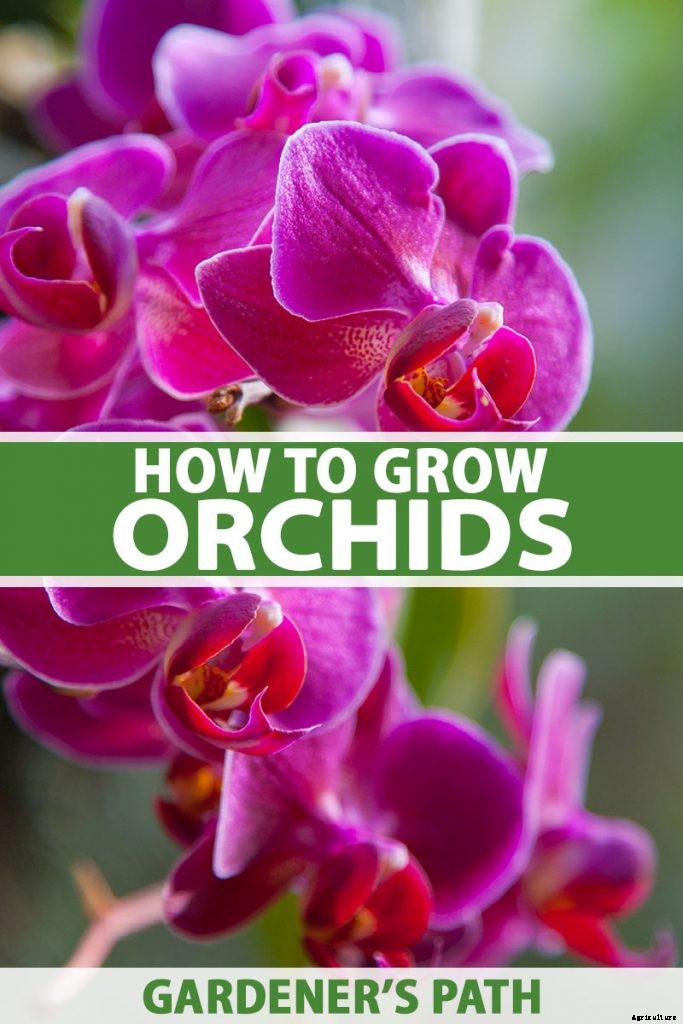
ラン科
蘭はゴージャスな観葉植物を作り、適切な注意を払って、 成長しやすいです。
この包括的なガイドでは、さまざまな種類の蘭と、これらの見事な植物の世話をする方法の基本について学びます。
蘭は神秘的で珍しいように見えるかもしれませんが、 植物界の貴重な宝石のように。しかし、おそらく定期的に(少なくともシードの形で)それらに遭遇するでしょう。
パントリーや冷凍庫にある可能性は十分にあります。たぶん、あなたは今朝朝食と一緒にヨーグルトでいくつかを食べさえしました。
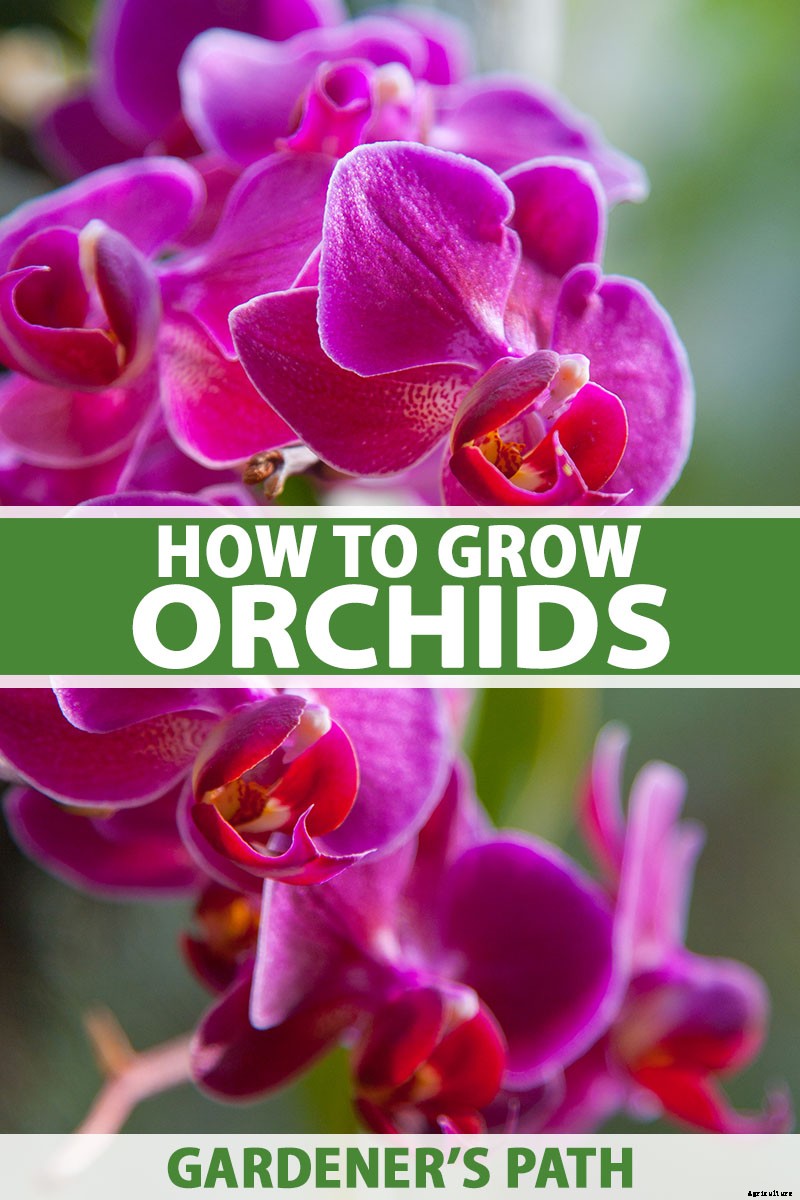
私は蘭の世界の料理のスター、バニラについて話している。
そう、 キッチンに実際の蘭の植物がなくても、 パントリーに純粋なバニラエッセンスがある場合は、 次に、蘭の家族の1人のメンバーの種子から作られた準備があります。
そして、あなたが小さな黒い斑点が入っているタイプのバニラアイスクリームのファンなら、 それからあなたは見ました、 食べて、 実際の蘭の種。
それらの小さな黒い斑点のそれぞれが種です。と V.プラニフォリア 極小の種子を持つ蘭だけではありません。いくつかの蘭のさや、 手に持ちやすいサイズで、 できる 数百万を含む 小さな小さな種の。
そして、バニラが多くの異なるデザートに甘美な風味をもたらすように、 観葉植物として、 蘭は私たちの家に魅力的な美しさをもたらします。
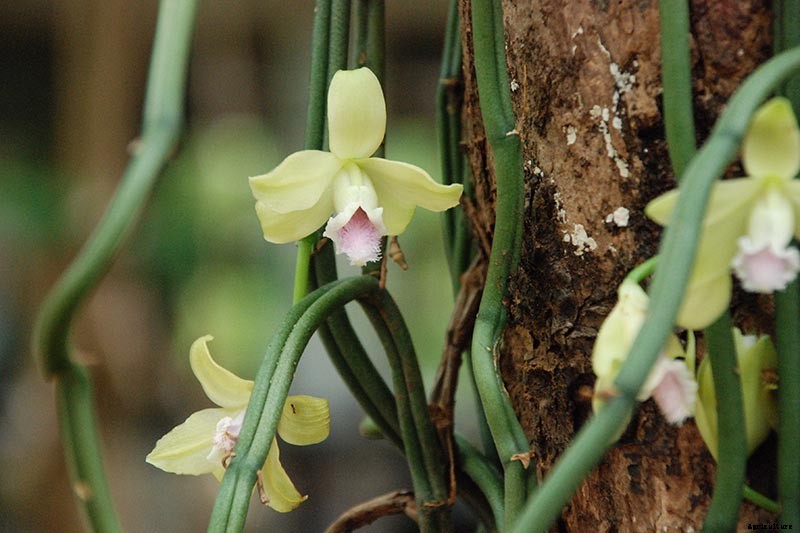
家でこれらの植物を育てるのは恐ろしいかもしれません、 でも難しいことではありません
実際には、 生き残るのに苦労しているほとんどのランは、少なすぎるのではなく多すぎる注意の結果として繁栄することができません。
の知識 正しい種類 特別な注意を払って 一方で、 あなたを蘭を育てるプロに変えます。そして、それが私がここで提供するものです。
これらの美しさの1つを観葉植物として育ててみる準備ができたら、 彼らができるだけ長く成長し繁栄できるように、彼らの世話が何を伴うのかを理解する必要があります。
蘭の成長と世話の短期集中コースの準備はできていますか?これが私がカバーするものです:
学習内容
- 蘭とは何ですか?
- 栽培と歴史
- 伝搬
- 成長する方法
- あなたの植物を選ぶ
- あなたの蘭の家を歓迎する
- 温度
- 光
- 土
- 肥料
- 水
- 湿度
- 空気の動き
- 成長のヒント
- メンテナンス
- あなたの植物の葉をきれいにする
- 開花を奨励する
- 植え替え
- 選択する品種
- 害虫や病気の管理
- クイックリファレンス成長ガイド
蘭とは何ですか?
私たちのほとんどはこれらの観葉植物を熱帯種と考えるかもしれないので、 世界中のほとんどの場所で見られる在来の蘭があることを発見することは驚くべきことかもしれません、 北極圏の上から南パタゴニアまでの範囲。
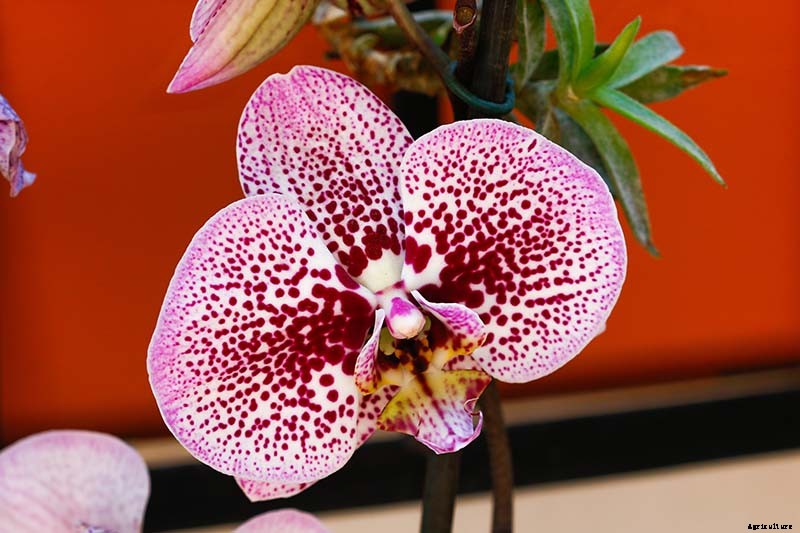
この記事は観葉植物として育てることができる品種に焦点を当てていますが、 あなたのフラワーガーデンで屋外で育てることができる丈夫な蘭さえあります。
蘭は多年草です。彼らはしばしば木で育ちます、 アナナスや空気植物と同じように、 そしてそれらは2つの成長習慣のうちの1つを持つことができます:単脚または同所。
モノポディアルとは「片足、 」とは、単一の中心から上向きに成長する植物を指します。
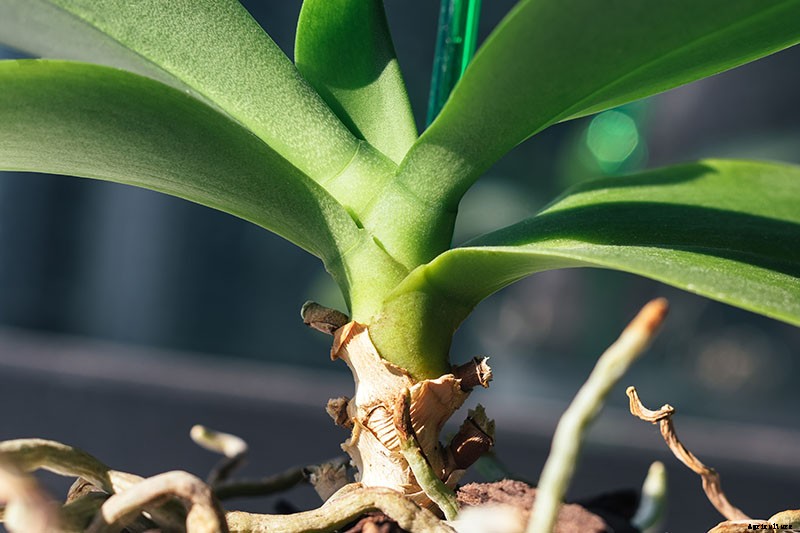
シンポディアルタイプ、 一方で、 持ってる 多くの フィート、 より凝集した形で成長しています。
一部の交感神経型には偽鱗茎があり、 干ばつ時に植物の水と栄養分を貯蔵するために使用される腫れた茎の基部。
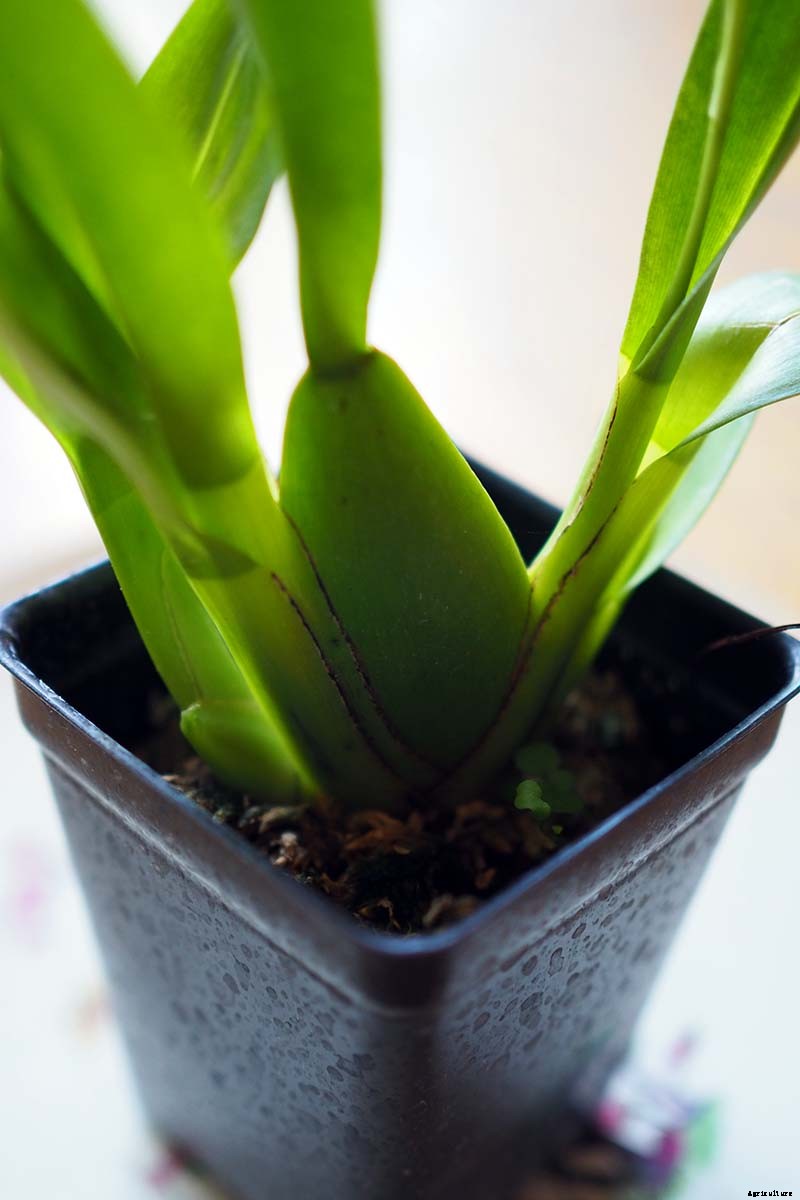
蘭は見事に印象的な花のために栽培されています、 1日以内に持続する可能性があります または最大数ヶ月、 種や品種によって異なります。
葉にも美しい模様を示す種もありますが、 特定の種類のパフィオペディルムやジュエルランなど。
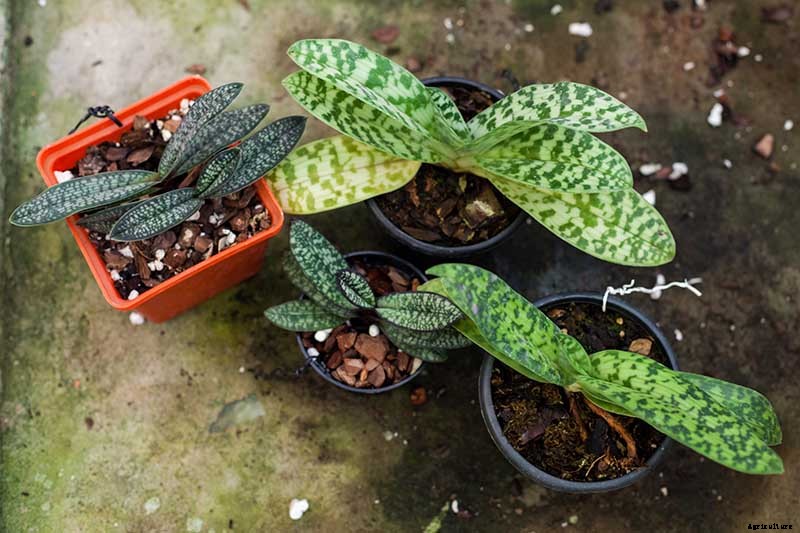
熱心な蘭愛好家は、開花していないときは、これらのさもなければ温厚な植物を周りに置いておく用意があります。 花が現れるとき、 まるで天国が別れ、天使の聖歌隊が現れたかのように感じます。
いくつかの植物は一度に一輪の花しか生産しないかもしれません、 いくつかはいくつかを生成する可能性があります、 そして他のものは花の全体の塊を生み出すかもしれません。
あなたの植物が一度に生産する花の数は、種や品種によって異なります。植物の年齢も、それが生産する花の数に影響を与える可能性があります。
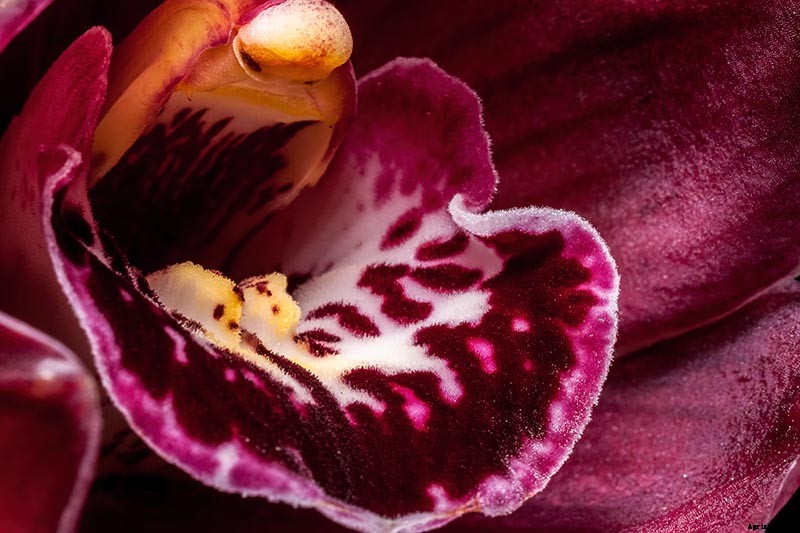
これらの派手な花は、花粉交配者を引き付ける唇または唇弁と呼ばれる修正された下の花びらを持っています、 植物の繁殖の可能性を高めます。セックスがすべてです、 赤ちゃん。
彼らは私たち人間にとっても非常に魅力的です、 見事な色の配列で、 パターン、 そして時々酔わせる香り。
別の理由で彼らが興味をそそられるかもしれません、 あまりにも–彼らは特に魅力的な特定のタイプの対称性を持っています。
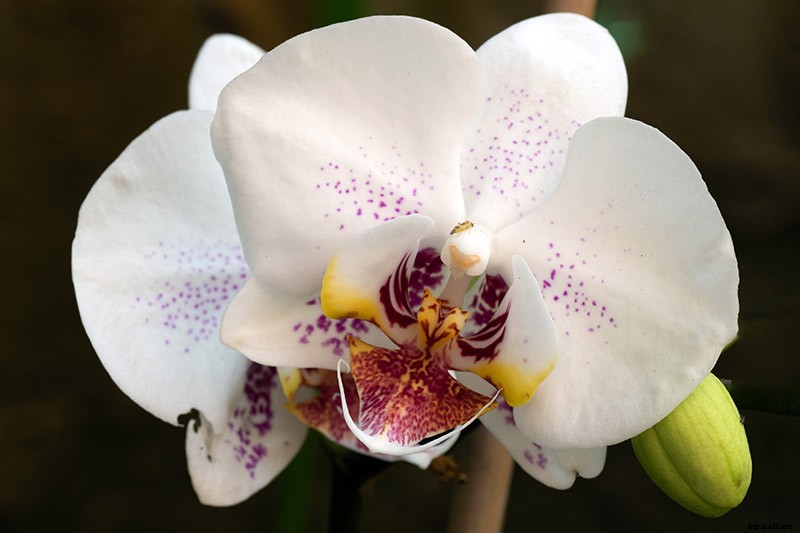
他の花が対称的でないわけではありませんが、 しかし、それらの多くはあまり説得力のない方法で対称的です。
取る ひまわり 、 百日草 、 また 宇宙 、 例えば。これらの素敵な花のそれぞれは、ずっと対称的です–花を正面から見ると、 明らかな上部または下部はありません。
蘭、 一方で、 持ってる 二国間 対称、 つまり、人間の顔のように、お互いの鏡像である2つの半分があり、ここで上部を認識します。 底、 と正中線。
いくつかの蘭の花も 見る 小さな顔のように。
これらの花の多く 花粉交配者を模倣する 彼らは引き付けようとしています。
そのような例の1つは、ハチランです。 Ophrys apifera 、 ミツバチに似ている、 私たちの目にだけでなく、 だけでなく、それと交尾しようとするオスのミツバチの複眼にも。
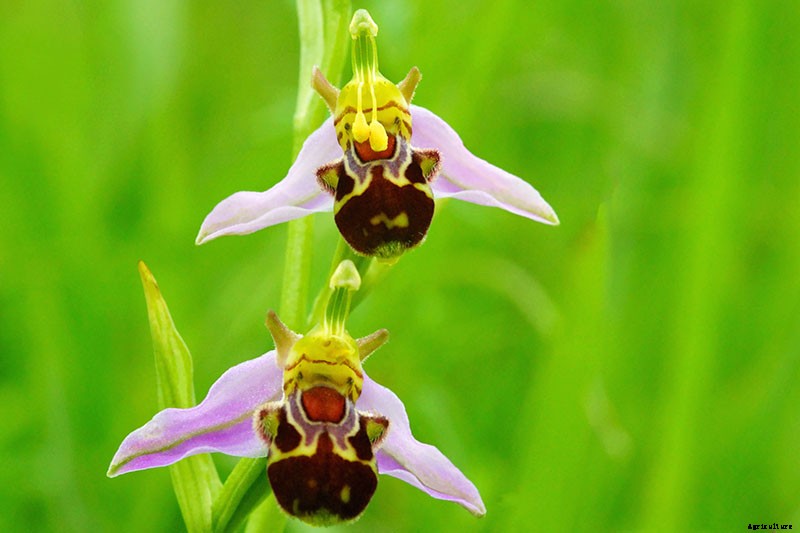
この模倣により、非常に興味深い花の形やパターンが生まれます。これが、芸術作品であるかのようにこれらの花を収集する人がいる理由かもしれません。
栽培と歴史
あなたはおそらくそれらを見てもそれを推測することは決してないでしょうが、 これらの花は遠い関係にあります アスパラガス 。
ランとアスパラガスの両方の家族は、分類学的にアスパラガスの順序で分類されます。
「蘭」という名前は、単一の種や特定の属を指すものではありません。ランは、ラン科と呼ばれる非常に大きな被子植物の分類学的ファミリーを構成しています。 周りを含む 30、 000の異なる種 。
物事を展望するために、 つまり、哺乳類の種の4倍以上のランの種が存在するということです。
分類学上の家族のもう1つのおそらくより関連性のある例は、飼い猫とチーターの両方を含むネコ科のネコ科です。
それはこの記事を書くことを意味します、 「蘭101、 」は、「猫の世話をする方法」というタイトルの記事を書くようなものです。 」とそれが飼い猫とチーターの両方の世話をカバーすることを期待しています。
はい、 2つの間にいくつかの基本的な類似点があります、 しかし、見逃したくない重要な違いは間違いなくあります。
ネコは37種しかありませんが、 そこにある何万もの蘭と比較して。
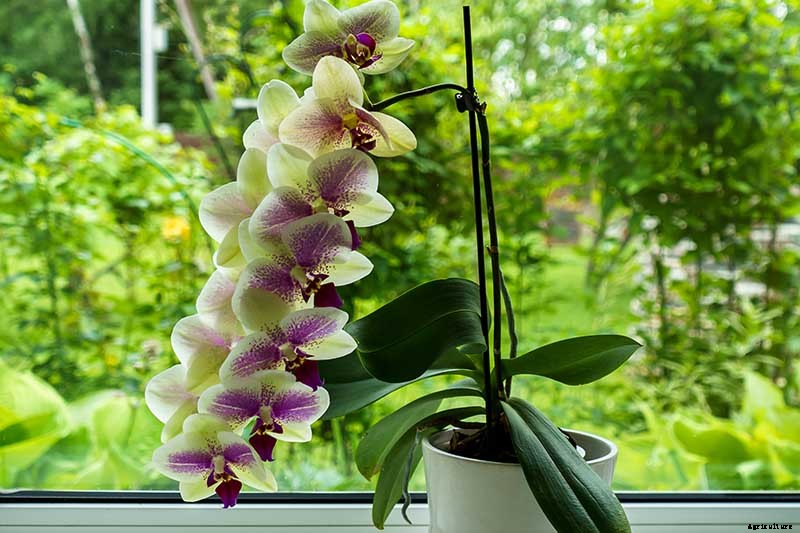
蘭の世界では、 おそらく非常に人気のある胡蝶蘭は、飼い猫に最も似ています。 あなたの窓辺に座ってその人生を生きて幸せです、 その間 バニラプラニフォリア 、 おいしいバニラビーンズのソースの1つ、 チーターのようなものです、 繁栄するために温室条件を必要とし、100フィート以上の長さになる可能性があります。
私はこの比較を提供して、あなたが持っている蘭の種類を見つけることがどれほど重要であるかを強調します。 だからあなたはそれに最高のケアを提供することができます。
ペットのチーターが窓辺に静かに座っているとは思わないでしょう。 あなたは?
これらが主に熱帯植物だと思ったら、 野生では、 ランは南極大陸を除くすべての大陸で育ちます。
グリーンランドの南端でさえ成長する種もあります!
人間が住むほとんどすべての気候において、 これらの印象的な花もあります、 木の隙間で成長し、 岩の上で、 または林床の落葉落枝。
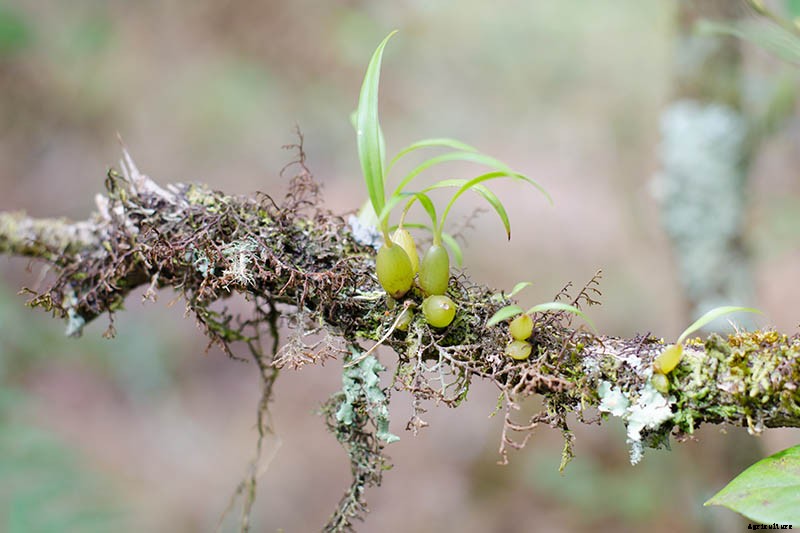
そして、これはこの記事からの最も重要なポイントの1つです。これらの植物の大部分は土壌から成長しません。 しかし、成長する表面にしがみつく気根があります。
しかし、 これらの植物をフリーローダーと思わないように、 彼らは木で育つかもしれませんが、 それらは寄生虫ではありません。
蘭は4つの異なるタイプに分類することができます、 彼らが彼らの本来の生息地でどのタイプの表面で成長するかに応じて:
- 着生植物–木で育ち、 多くのアナナスがそうであるように。
- 岩生植物–岩の上で育ちます。
- 半陸生–地面で物質を分解して成長します。
- 陸生–非常に少数の種が土壌で成長します。
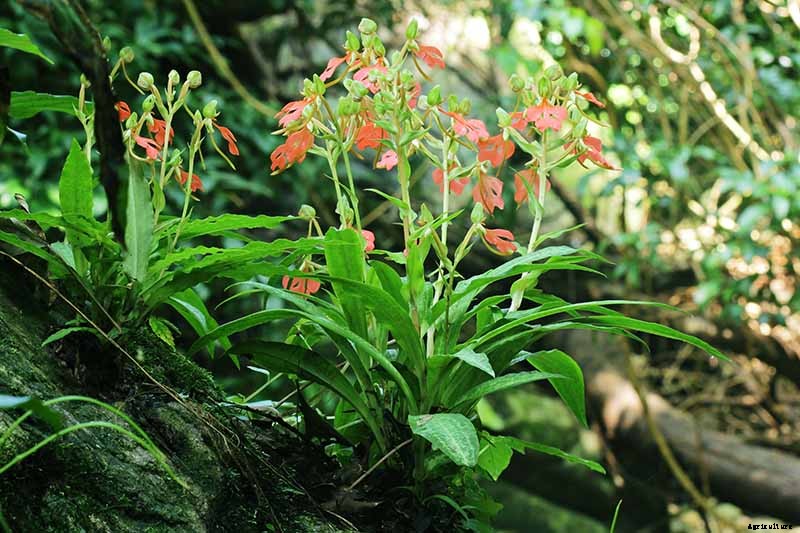
これらの異なる自然の生息地は、私たちがこれらの植物の1つを私たちの家に持ち込むときに知っておくべきさまざまな明確な要件をもたらします。
いくつか、 シンビジウムなど、 明るい光と涼しい温度に使用され、 他の人が 胡蝶蘭など、 薄暗い光と暖かい環境を好みます。
少なくとも孔子の時代から、人間はこれらの花を賞賛してきました。 誰が書いた 彼らへの彼の崇拝について。そして、1200年代までさかのぼって中国で書かれている蘭のフィールドガイドがありました。
西に、 1700年代まで、家でこれらの花を育てたという記録はありません。
1800年代までに、 彼らは裕福なヨーロッパ人の間で人気になりました、 探検家を派遣して、遠くの土地で珍しい標本を見つけ、特別な保護ケースに入れて家に持ち帰りました。
1600年代のチューリップマニアのように、 これが「オーキデリリウム」の始まりでした。
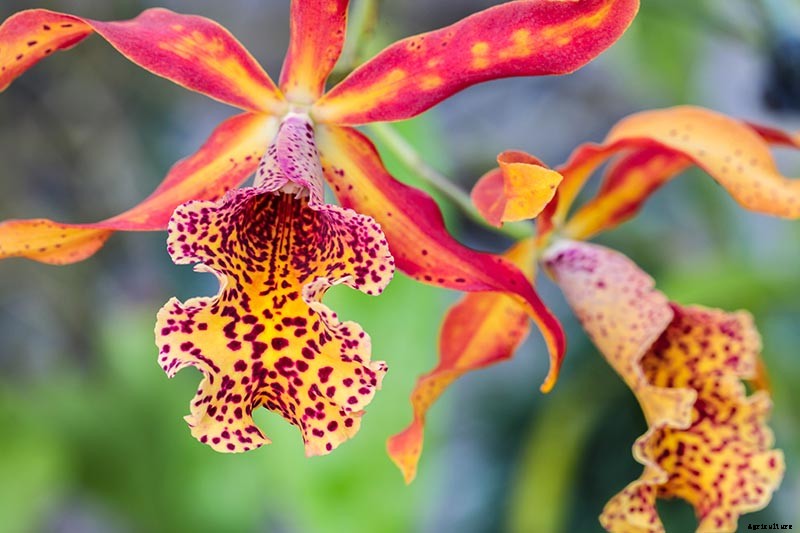
不幸にも、 これらの躁病のコレクターは、植物がすべて暑くて蒸し暑いジャングルから来たと仮定しました、 そして彼らに彼らの家で最も蒸し暑い成長条件だけを提供しようとしました。
彼の著書「蘭の歴史」では、 」 アマゾンで利用可能 、 著者のMerleA。Reinikkaは、これらの輸入品は、可能な限り高温に保つことを目的とした炭層で加熱された「ストーブ」に収容されることが多いと説明しています。
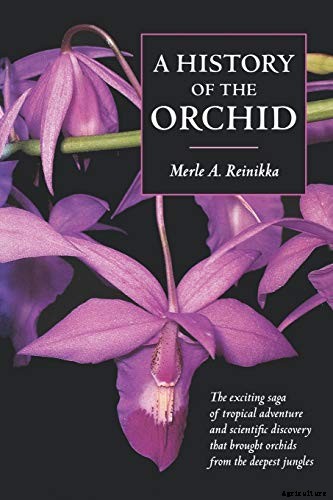
蘭の歴史
これらの暑さに耐えた種、 乾燥状態はごく少数でしたが、 そしてほとんどの植物はこの処理で死にました。
大西洋の反対側では、 この間、南フロリダの野生のランはほとんど一掃されました。 コレクターがそれらを鉢植えの観葉植物として育てるために野生からそれらを取り除いたとき。
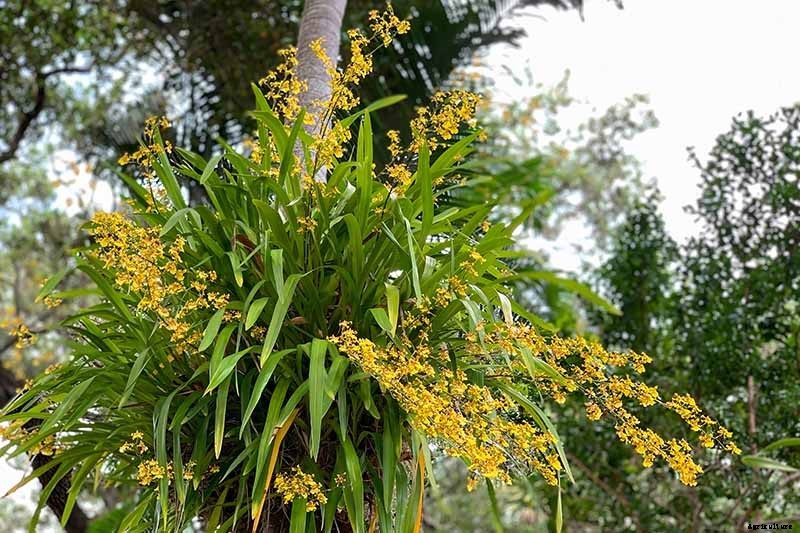
蘭に頼んだら 彼らの 視点、 彼らは、蘭が終わらないことを主張するかもしれません。
不幸にも、 野生から希少種を探して取り除く習慣は、熱心なコレクターを満足させるために今日でも行われています。 スーザンオーリアンの本「TheOrchidThief」を読んだり、それがインスピレーションを得た映画を見たりした場合は、ご存知かもしれませんが、 適応、 とらえどころのない絶滅危惧種のゴーストランを密猟者が探していることについて。
悪意のある人身売買業者は、野生から珍しい標本を不法に収穫します。 これらの植物を絶滅の危機にさらします。
レイチェルベールによると、 の編集者 ナショナル・ジオグラフィック 、 「一部のランは、人口のわずか5%が収穫された場合、絶滅の危機に瀕していることが示されています。」
野生のこれらの壮大な植物の消失に寄与することを避けるために、 常に信頼できる情報源から植物を選択するようにしてください。
アメリカ蘭協会 (クローニングを介して)種子または組織から繁殖した栽培品種のみを購入することをお勧めします。 違法な収穫を思いとどまらせるため。
幸いなことに、 これらの植物に夢中になっている私たちにとって、違法に収穫された標本の購入に頼ることなく、そのかゆみを掻く方法はたくさんあります。
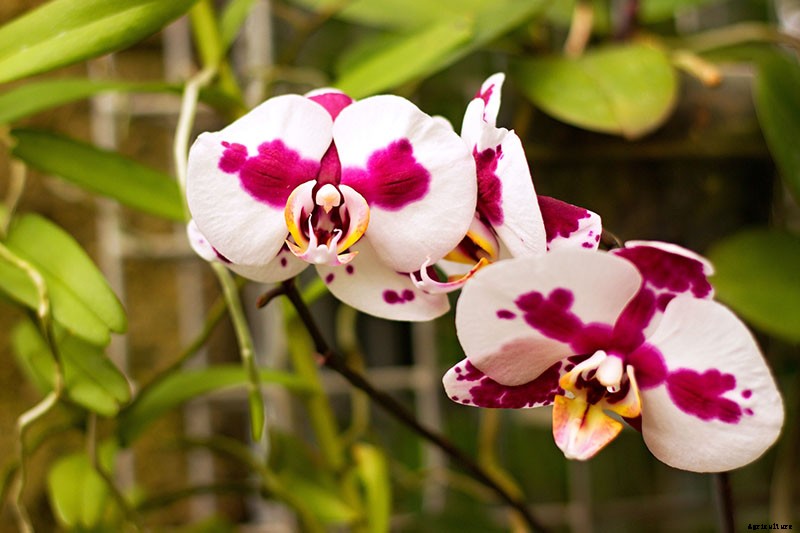
私たちのような人々が観葉植物として持つことができるすべての種が利用できるわけではありませんが、 それは私たちの選択肢が厳しく制限されているという意味ではありません。
蘭の家族には900以上の異なる属があります、 そしてそれらの多くは、異なる種間または異なる属間でさえ容易にハイブリダイズします。 ブリーダーに魅力的なハイブリッドを作成するための多くの可能性を提供します。
現在まで、 園芸家は100以上を生産しました、 000の栽培品種、 そしてその数は増え続けています。
一部の種は薬用にも使用されていますが、 料理のスターバニラは別として、 ほとんどはとして成長します カラフルな観葉植物 またはコレクションの標本として、 対称性の高い美貌で私たちの生活をより甘くします。
伝搬
大型スーパーや食料品店で蘭を購入する場合は、 組織培養から成長した可能性が非常に高いです。
もしそうなら、 あなたの植物はメリックロンとして知られています、 植物から組織サンプルを成長させることによって作成されたクローン。
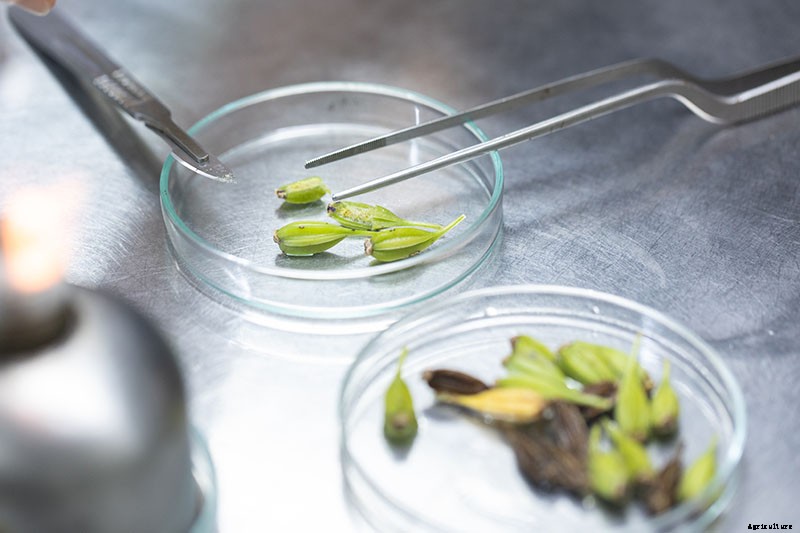
この伝播手法は商業生産者には有効ですが、 より多くの人々に手頃な価格の蘭を提供できるようにし、 家庭菜園プロジェクトというよりは、実験室での実験です。
そして、種子からこれらの花を育てています。
これは、シードが非常に小さいため、次のような復元力が組み込まれていないためです。 いう、 NS 押しつぶす シード。
野生で、 ランの種子は、発芽して成長するために有益な真菌とのパートナーシップに依存しています。
これが、ランの植物が売りに出されているのをよく目にする理由ですが、ランの種は それほど多くはありません。
まだ、 種子からこれらの観葉植物を育てる は 必要なすべての機器に投資する意思がある場合は、自宅で行うことができます。 フラスコを含む、 ライトを育てる、 寒天、 と栄養素の混合。
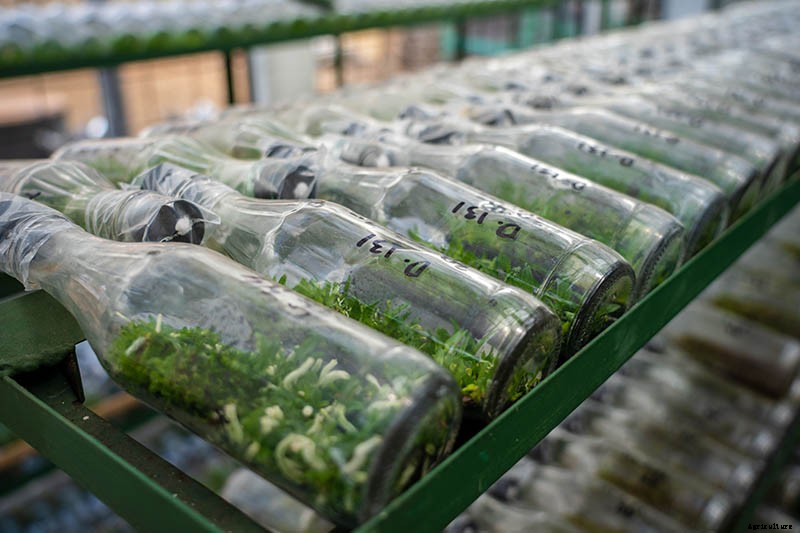
種まきと組織培養に加えて、 それらは、平均的な家の庭師にとってより実用的な方法で繁殖する可能性があります(ただし、すべての方法がすべての種類のランに適用されるわけではありません)。
- 分割
- バックバルブ
- 茎の挿し木
- 苗木(けいけい)
- 気根
種子からランを育てると、親植物とは異なる特徴を持つ花が咲くことがありますが、 これらの他の方法はクローンになります、 だからあなたの植物がどんな種類の花を作るかについて驚くことはありません。
これらのさまざまな伝播方法の詳細を知りたいですか?蘭の繁殖に関する記事を必ずチェックしてください。 (( 近日公開 !)
成長する方法
これまでよく読んでいたら、 あなたは非常に多くの異なるタイプで、 それらすべてをカバーするための最良の成長条件の絶対的なセットはありません。
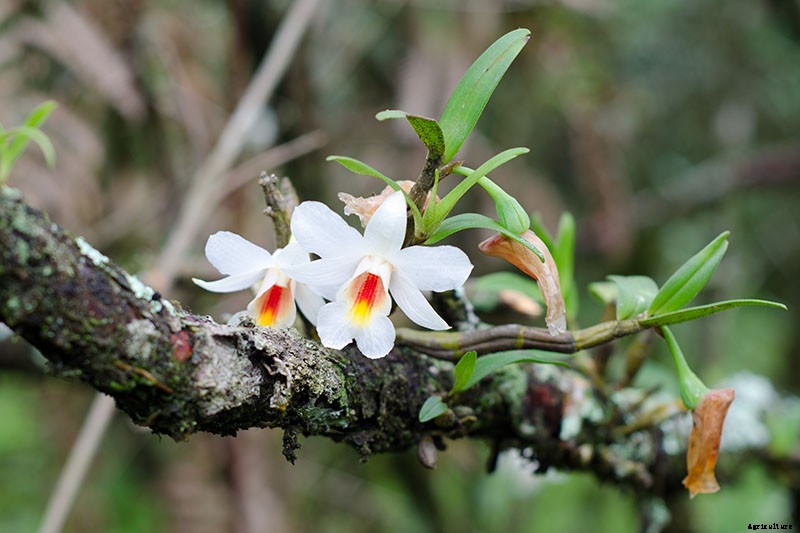
同じ属の中でも、 種が異なれば、温度に関しても要件が異なる可能性があります。 水やりの頻度、 日光の量、 と湿度。
したがって、適切に識別された栽培品種で蘭の成長の冒険を始める場合は、 それに最適な条件を見つけるのが簡単になります、 必要なものを正確に提供します。
しかし、 食料品店で購入した蘭の種類が正確にわからない場合があります。 (けれど、 そうだとすれば、 おそらく胡蝶蘭です。)
プラス、 これらの植物は容易に交雑するので、 異なる属の間でさえ、 これらの属間雑種の多くは市販されていますが、 識別はさらに簡単ではありません。
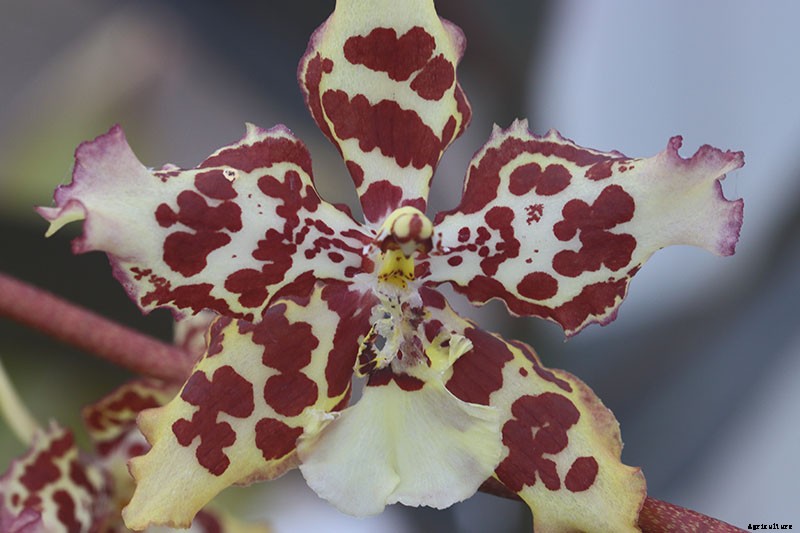
次のケアの推奨事項では、 一般的なガイダンスといくつかの詳細を提供します。
あなたの植物を選ぶ
あなたがあなた自身の蘭の世話を始める前に、 健康な植物を家に持ち帰るために何を探すべきかを知る必要があります。
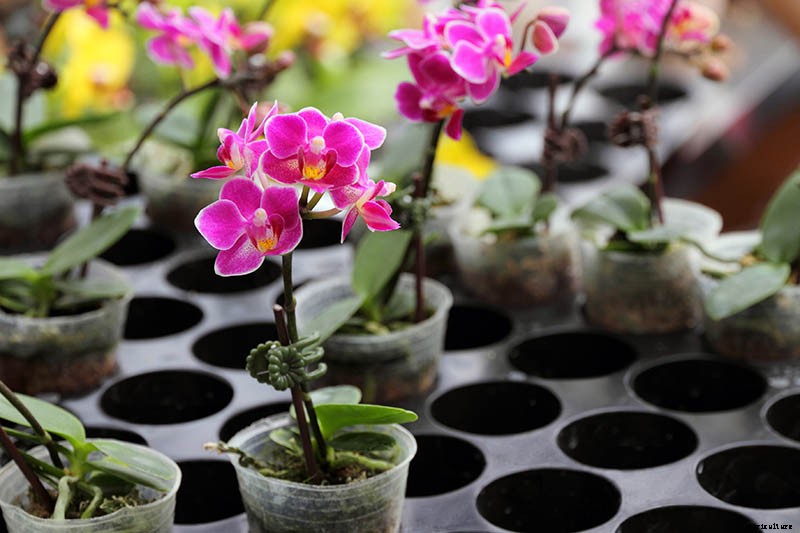
植物が透明なプラスチック製の鉢に植えられている場合、 これは素晴らしい、 蘭の上部だけでなく、 しかし、そのルーツも–健康の重要な指標です。
蘭を選ぶときに探すべきものは次のとおりです。
- 葉は中程度または薄緑色でなければなりません、 濃い緑色ではありません。
- 葉はふっくらしている必要があります、 しわや革のようなものではありません。
- 葉にシミや変色があってはいけません。
- 根は鍋にぴったりと収まる必要があります-彼らはあまり余分なスペースを持ってはいけません。
- 表示されている場合、 根はふっくらと見えるはずです、 しわが寄ったり、どろどろしたりしません。
- 根は緑または灰色がかった緑でなければなりません、 気根は白くてしっかりしている必要があります。
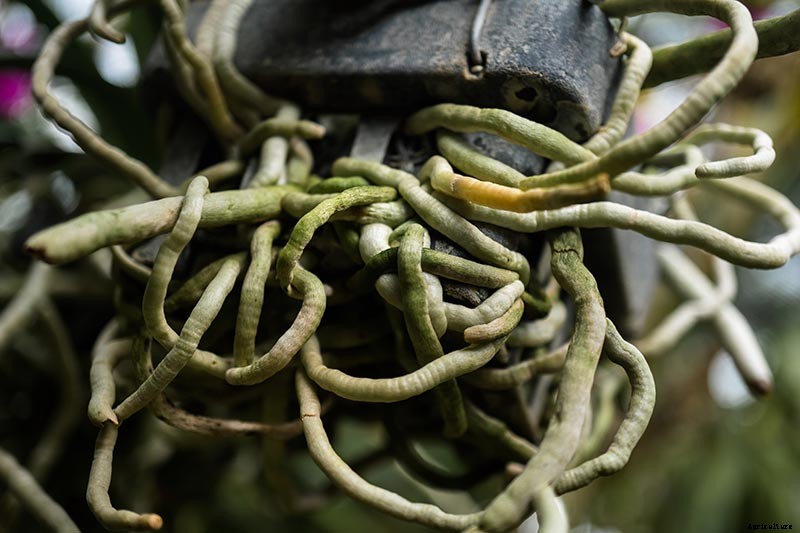
- 植物が咲いている場合は、 花は傷がないはずです。
- 植物全体に害虫や病気の兆候がないようにする必要があります。
- 新しい成長の兆候を探し、 これは健康な標本を示している可能性があります。
- 植物が入っているポットには、適切な排水穴が必要です。
もう一つの良い考えは、成長する培地の匂いを嗅ぐことです。ファンキーな匂いがするなら、 根はおそらく腐っています。そうだとすれば、 この植物を渡して、より健康なものを探してください。
あなたの植物の家を歓迎する
あなたが店または庭の苗床からあなたの植物を家に持ち帰るかどうかにかかわらず、 またはオンラインで注文する、 到着したら、フレンドリーに歓迎します。
オンラインで購入した場合は、 植物の周りのパッケージをそっと開梱します。輸送中にパッケージが逆さまになったり、投げられたりした場合でも、植物を保護する方法で梱包されている必要があります。
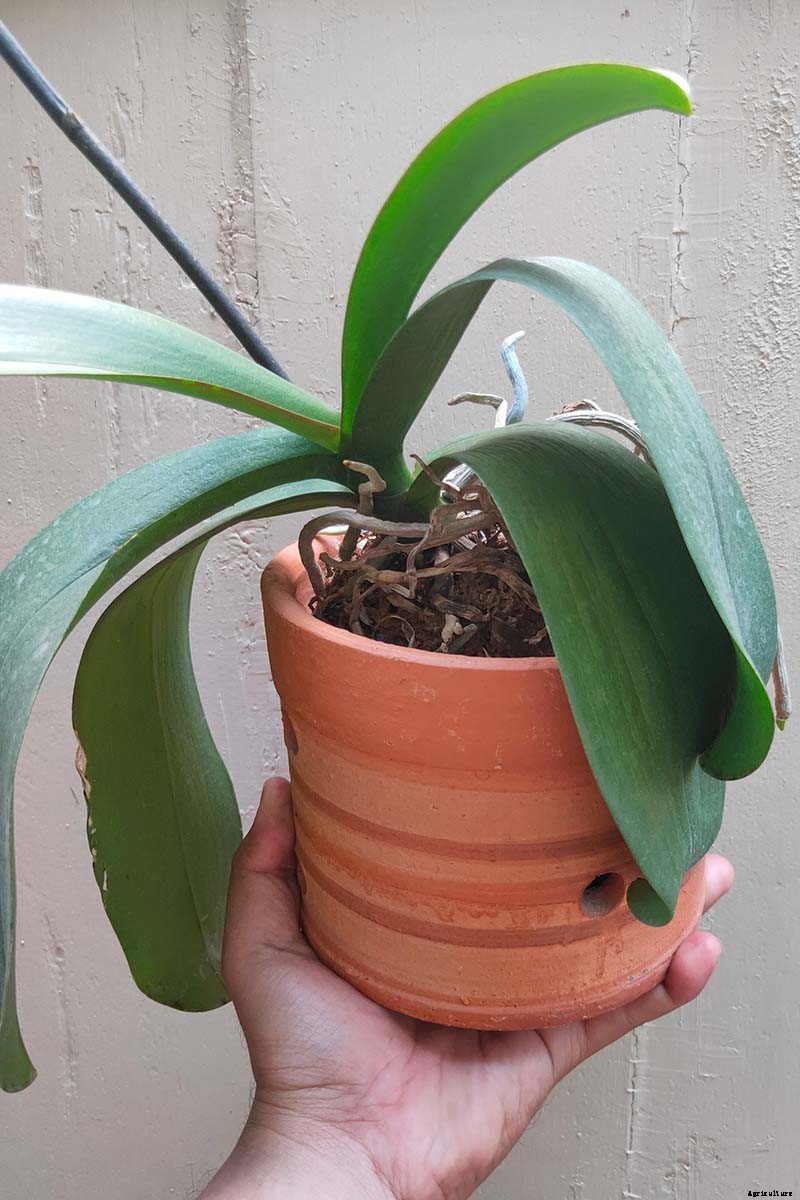
最初は高温や明るい光にさらされない家の場所に配置することをお勧めします。その代わり、 中程度の場所を選択し、 間接光。
数日間回復させてから、恒久的な成長スポットに置き、徐々に通常の生活に戻します。
植物の鉢に指を突っ込みます–成長中の培地が乾燥していると感じた場合は、 さあ、水をやりましょう。さもないと、 水を飲むまで2、3日待ちます。 またはそれが新しい家に慣れるまで。
食料品店や大型スーパーセンターから新しい植物を購入した場合は、 新しい場所に数日置いてから、先に進んで植え替えることをお勧めします。
定期的な水やりの必要性を減らすために、 これらの施設で販売されている植物は、多くの場合、根を湿らせた状態に保つ成長培地に植えられます。通常は湿りすぎます。
植物を適切な成長培地に植え替えて、右足から始めます。以下の植え替えの手順を確認してください。
温度
一般に、 蘭は、日中の気温が約70〜80°Fのスイートスポットに維持されている場合に最も効果的です。
加えて、 ほとんどはまた少なくとも温度を好む 10〜15度涼しい 夜–そして多くの品種にとって、これは好ましいだけでなく、開花を促進するために必要です。
そのスイートスポットを超えて、 ほとんどのタイプが許容できる最低温度は50°Fです。 推奨される最高温度は通常95°Fです。
この範囲外の温度は必ずしもあなたの植物を殺すわけではありません、 しかし、彼らは彼らにストレスを与えるでしょう、 昆虫や病気の問題をより受けやすくし、 開花する可能性が低くなります。
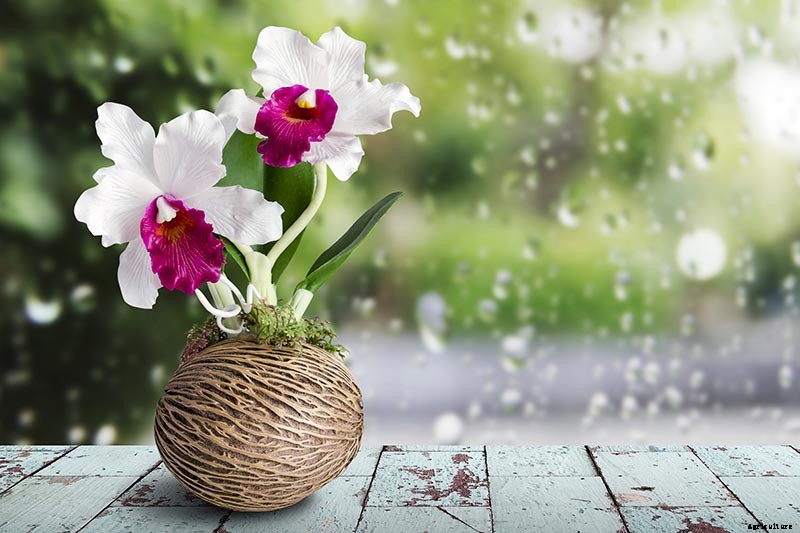
スペクトルの暖かい方の端にはより多くの小刻みに動く余地があり、冷たい方の端にはあまりありません。観葉植物として飼育されているランの大部分は霜に敏感であり、非常に低い温度にさらされるべきではないことに注意してください。
これらの植物は、しばしばそれらの温度の好みの観点から分類されます。
いくつかはクールな栽培者と見なされます、 いくつかの暖かい栽培者、 中にはその中間にあるものもあります–これらは中間栽培者として知られています。この情報は、必ずしも植物のラベルに記載されているとは限りません。
クールな栽培者
涼しい栽培者は、日中の平均気温が華氏60〜75度であることを好みますが、夜間の気温は華氏50〜65度の範囲である必要があります。
これらには標準が含まれます シンビジウム 、 オドントグロッサム 、 ミルトニオプシス 、 そして多くの パフィオペディルム 種族。
中級生産者
中級栽培者は、日中の平均気温が華氏65〜80度、夜間の気温が華氏55〜70度を好みます。
これらには以下が含まれます カトレア 、 ミルトニア 、 と デンドロビウム 種族。
暖かい栽培者
暖かい栽培者は70-90°Fの平均日中の温度を必要とします、 夜間の気温は約60-75°Fである必要があります。
これらには以下が含まれます 胡蝶蘭 とほとんどの種類 バンダ 、 としても パフィオペディルム まだらまたはストラップ形の葉を持つ種。
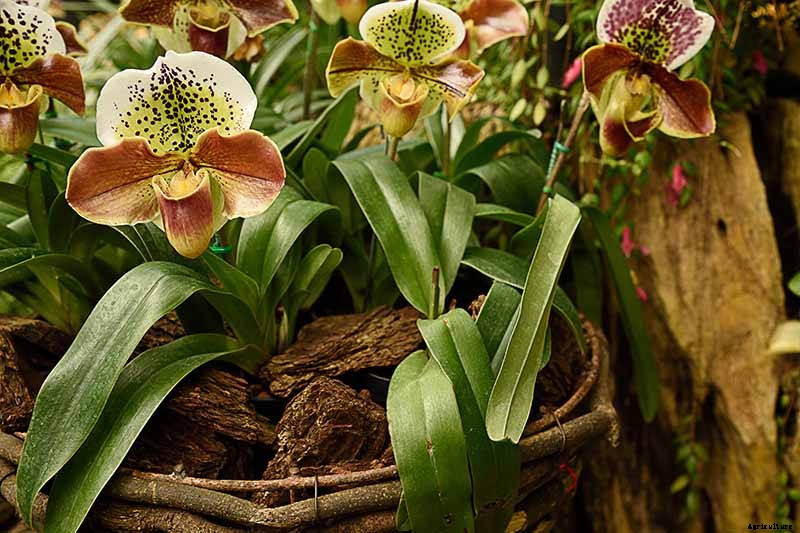
あなたの植物は冬の間、温度範囲のより涼しい端を好むと仮定するのは安全です、 そして夏の間のハイエンド。
昼/夜の差
夜間の気温を下げることを好むのは、蘭だけではありません。これは「昼/夜差」またはDIFと呼ばれます。 および他の観葉植物など クリスマスサボテン と ポインセチア これを好む、 それも。
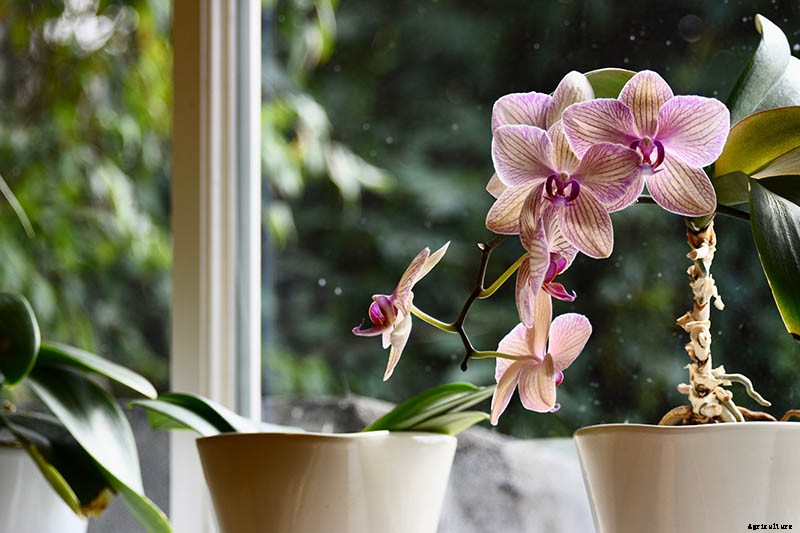
あなたの植物に夜により涼しい温度を提供するために:
- 可能であれば、 窓は夜に冷えるので、窓辺またはその近くに置いてください。
- 冬に、 強制通気口やラジエーターから離して配置してください。
- 夜はサーモスタットを下げてください。
光
光の要件については、 これはあなたが知る必要があることです:あなたの蘭を明るくしてください、 間接光。使用しているタイプがわからない場合、これは大まかな目安です。
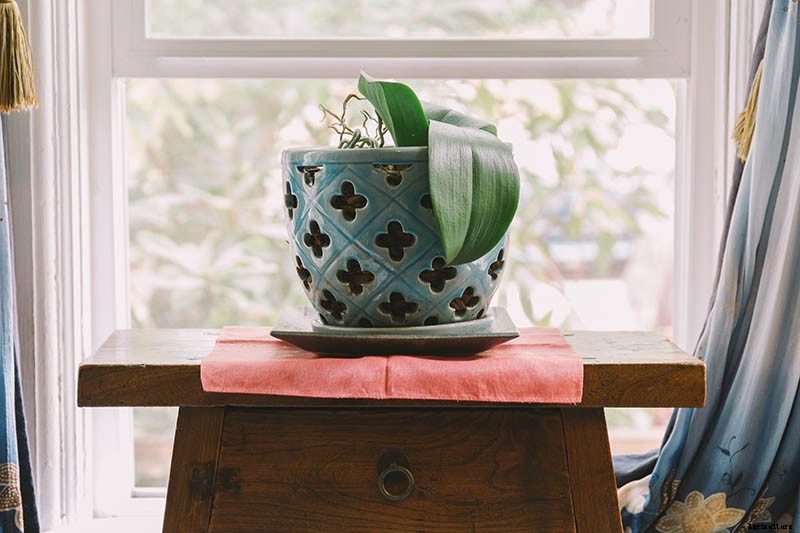
もちろん、 もし、あんたが NS あなたが持っているタイプを知っている、 実際には、さまざまな種や栽培品種の間で、より微妙な範囲の光の好みがあります。
これはこれらの花のファンにとって朗報です、 私たちの家のさまざまな場所でそれらを育てる可能性を広げます-いくつかの栽培品種は、南の窓の近くのより明るい場所に置くことができます、 暗い場所で幸せに暮らせる人もいますが、 東の窓の近くなど、 間にオプションもあります。
実際には、 あなたの家で利用できる光の量に応じてあなたの品種を選ぶことは素晴らしい考えです。これらは、ほとんどのラン属の一般的な適応症です。 ただし、特定の種や品種のケアガイドを常に再確認してください。
より高い光の種
より明るい種には、からの多くの品種が含まれます カトレア 、 シンビジウム 、 アスコセンダ 、 フラグミペディウム 、 ブラッシア 、 バンダ 、 と デンドロビウム 属。
これらは、木や薄手のカーテンからの陰影がある南向きの窓の近くに配置できます。
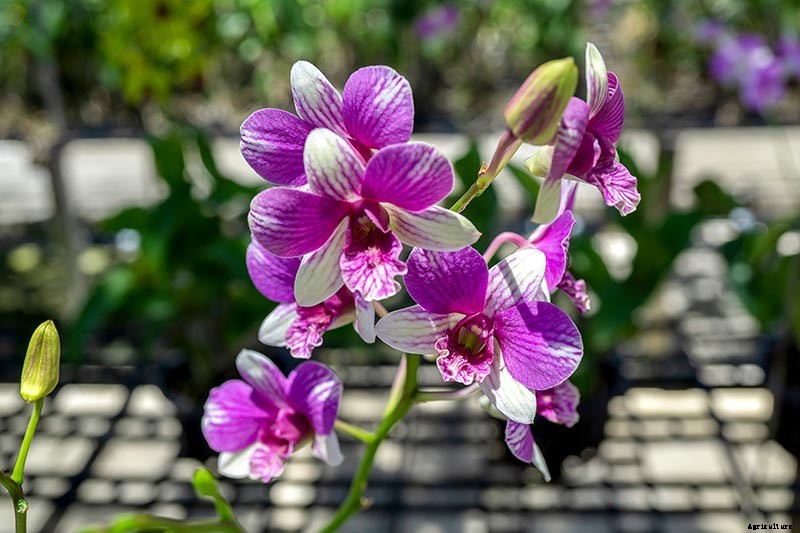
デンドロビウムは、朝の直射日光に耐えることができます。 ただし、日中に直接光を当てないでください。または、窓から1フィートほど離れた場所に置いてください。
ミディアムライト種
中程度の軽い種が含まれます オンシジューム 、 ミルトニア、 とミニ カトレア 種族。
これらは南の窓から少し離れて配置することができます、 または窓辺にありますが、木やブラインドのいずれかからより多くの陰影があります。
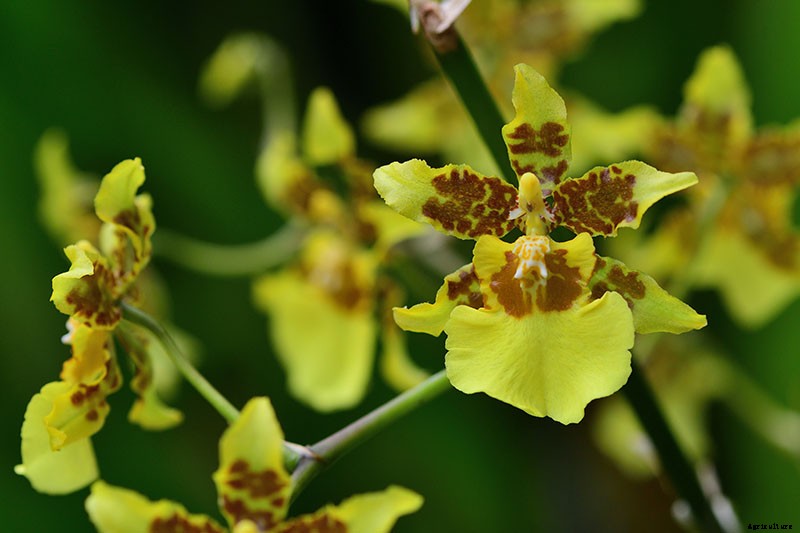
ミディアムライトタイプは、西向きの窓の近くでもうまくいく可能性があります。 暑い夏の日にその地域があまり熱くならない限り。
より低い光の種
低照度の種には、次の種類が含まれます パフィオペディルム 、 胡蝶蘭 、 と宝石の蘭。これらは、いくつかの例外を除いて、朝の光を受けるために東の窓の近くに配置する必要があります。
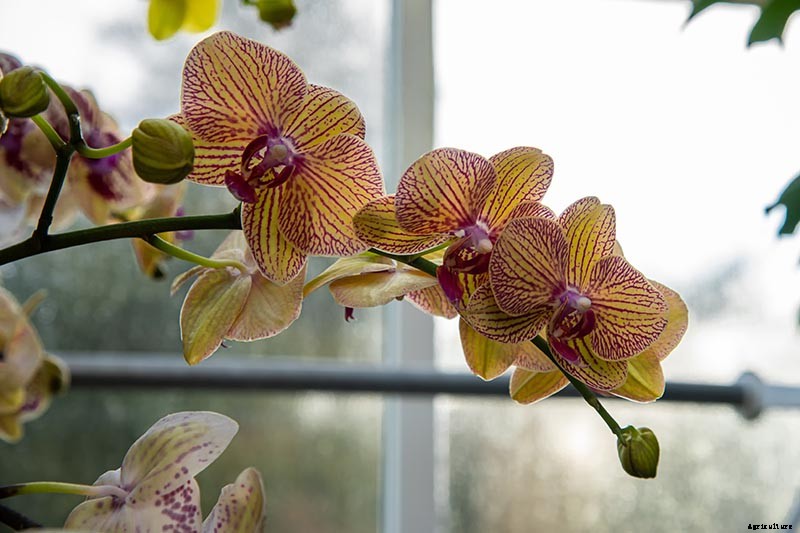
太平洋岸北西部のように曇りがちな気候に住んでいる場合は、 南向きの窓辺に低照度の種を配置する必要がある場合があります。
一方で、 私の非常に日当たりの良いユタ州北部の気候では、私はより低い光の種を育てることができました、 そしてそれらを開花させることさえ、 私の家の北側にある明るい窓の中で–彼らは明るい場所にさらされていました 間接光。
みんなの家は違います、 したがって、これらの一般的なガイドラインを状況や選択した種類の植物に適合させる必要があります。
照明のトラブルシューティング
これらの観葉植物が十分な光を得ているかどうかをどうやって知るのですか?
葉が濃い緑色の場合、 このように美しく見えますが、 これは実際には、彼らが十分な光を得ていないことを示しています。一般的、 葉は中程度からライムグリーンの色でなければなりません。
不十分な光はまた開花を防ぐことができます、 ですから、1年経っても植物が開花していない場合は、 あなたが試すことができます グローライトを使用 あなたの植物を助けるために、 またはそれをより日当たりの良い窓に移動します。
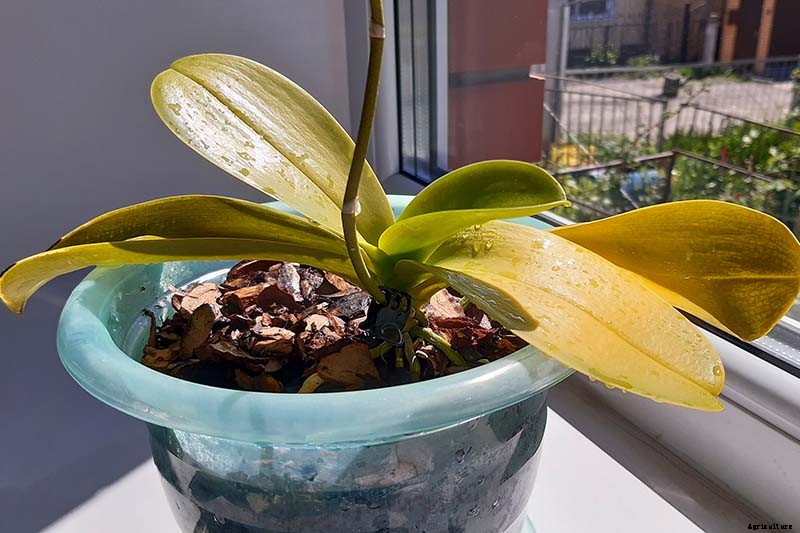
一方で、 植物の葉が赤みを帯び始めたら、 これは、過度の光にさらされていることを示している可能性があります。
この場合、もう少し日陰を設ける必要があります。 窓からさらに移動し、 または日中の日差しが少ない窓に配置します。
黄色に変わる葉も、光が多すぎることを示している可能性があります。
土
これはおそらくこれらの植物を育てる上で最も重要な部分です–鉢植えの土に蘭を植えないでください。私の後に繰り返して: 蘭を培養土に植えないでください 。
培養土は、植物の根を湿らせすぎて、必要な空気にさらされないようにします。
ごくわずかな例外を除いて、 これらの花は、わずかに酸性の条件で、木の隙間で成長します。 岩の上で、 または浅い、 林床の栄養素の少ない有機物。
これらの自然な成長条件を再現するには、 高品質を選択することが重要です 特殊な蘭の成長媒体–そしてそれは いいえ 培養土。
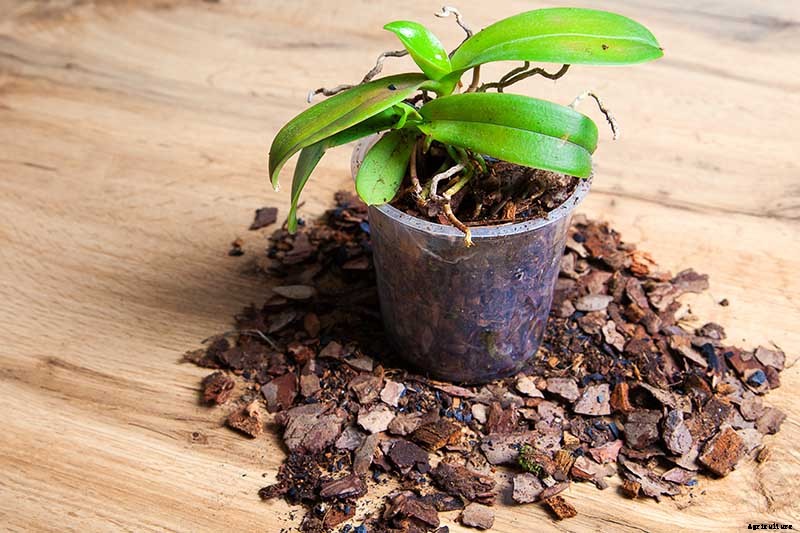
蘭の鉢植えに通常の培養土を使用しないことがわかったので、 より適切な成長培地を選択することをお勧めします。
使用できるさまざまな材料のいくつかを次に示します。
- 吠える
- 細断された木生シダ
- 木炭
- ピートモス
- ミズゴケ
- 粗いココナッツの殻
- ファインココナッツコイア
- パーライト
- 溶岩岩
- 膨張した粘土ペレット
- 砂利
成長培地は、上記の材料の1つだけで構成することも、2つ以上の材料の混合物で構成することもできます。
あなたは私たちのガイドであなた自身の蘭の成長媒体を選択または作成することのより細かい点についてもっと学ぶことができます( 近日公開 !)。
または、 あなたは、汎用のプレミックスラン成長培地から始めたいと思うかもしれません。
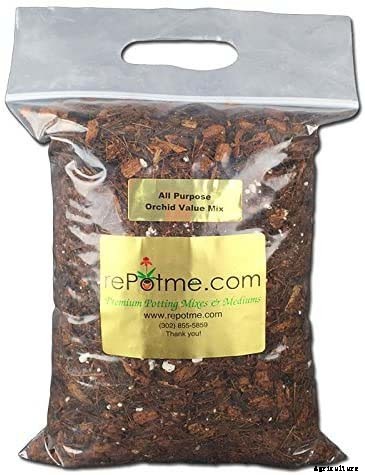
再封可能なバッグの4クォート万能蘭バリューミックス
rePotmeの万能オーキッドバリューミックスをお勧めします。ココナッツの殻の破片と小さなスポンジの岩が含まれています、 パーライトとも呼ばれます。
あなたは4クォートのバッグで購入するためにそれを見つけることができます rePotmeからAmazon経由 。
水
成長培地を選択した後、 水やりはおそらくこれらの観葉植物の世話の2番目に重要な側面です。
適切な頻度で水をやることが重要です。頻繁に水をやる場合は、 彼らの根は腐ることがあります、 それは彼らが必要な水を吸収するのを防ぎます、 最終的に彼らは脱水症で死にます。
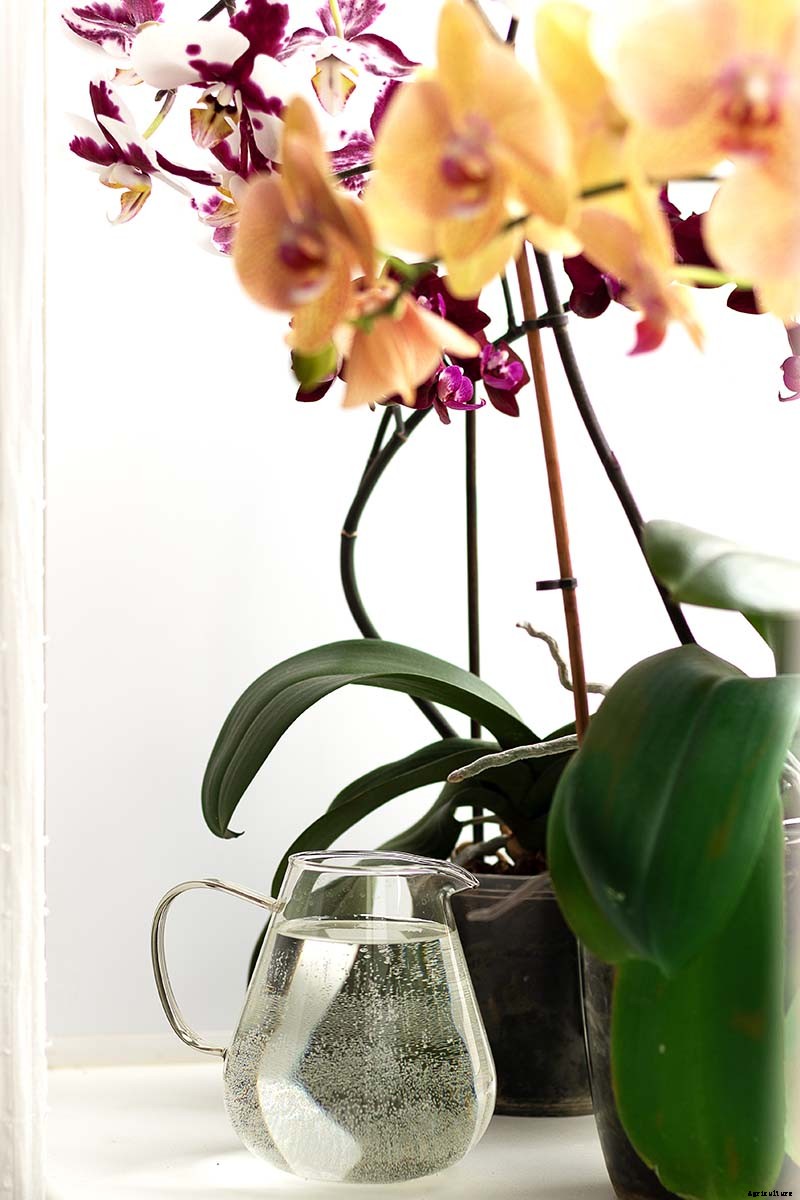
一方で、 十分に水をやらないと 彼らはまた脱水症で死ぬ可能性があります。
品種が異なれば必要な水量も異なるため、 あなたはあなたの植物を知り、それがどれくらいの頻度で水をまく必要があるかを決定する必要があるでしょう。
あなたは週に一度あなたの蘭に水をやることから始めて、そしてそれがどれくらい速く乾くかを見たらこれを微調整することができます。
あなたの散水頻度は以下に依存します:
- 種または栽培品種
- 成長培地の種類
- 温度
- ルートシステムはどれだけ発達しているか
- あなたの植物の年齢
- ポットの種類
- 根が鉢にどれだけぴったり合っているか
あなたの植物を拾い上げて、水をやった後にそれがどれほど重いかを知るようになります。 1週間または10日間毎日それを拾い続けてください。
鍋が軽く感じたら、 おそらく水を飲む時間です。非常に軽いと感じる場合は、 あなたはおそらくあまりにも長く待っていました、 将来的にはもっと早く水を供給するはずです。
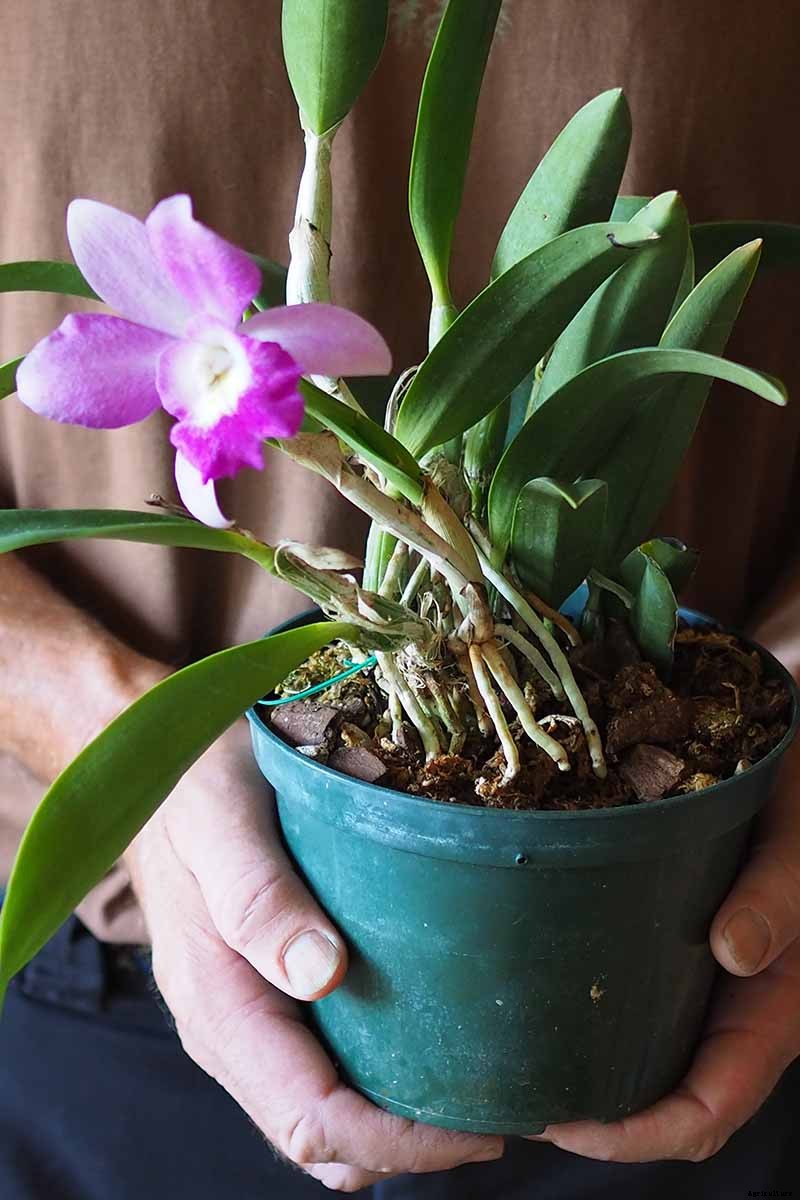
原則として、 植物に水をやる前にもう1、2日待つことができると思う場合、つまり、拾ったときにまだ少し重いと感じる場合は、おそらく待つ必要があります。
ただし、これらの推奨事項を種や品種に合わせて調整する必要があります。
常に均一に湿った状態を保つことを好む人もいますが、 パフィオペディルムなど、 週に2回水をやる必要があるかもしれません。
その他、 カトレアなど、 水やりの合間に乾くのが好きで、2週間ごとに水をやる必要があるだけかもしれません。
朝に蘭に水をやり、夜が明ける前に十分に乾かしてください。 ぬるま湯を使用し、 良質の水。
ゴールドスタンダードは、逆浸透によってろ過された水です。きれいに使用することもできます、 新鮮な雨水。
公共用水がある場合は、 都市の水道水には未知の化学物質の残留物がいくつも含まれている可能性があるため、ろ過することをお勧めします。 塩素に加えて。
あなたの植物が装飾的な植木鉢とそのプラスチック栽培者の鉢にある場合、 散水する前に装飾ポットを取り外してください。
蘭を一本一杯ボウルに入れるのが好きです。 培養土と根にぬるま湯を1カップほど注ぎます。 鍋から排出させて、 そして、ポットが重いと感じるまで、さらに数回繰り返します。
植物を受け皿に戻す前に、鉢を完全に排水させます。 鍋が水に浸かっていないことを確認します。
植物の葉の上に水をかけないように注意してください。 これは腐敗につながり、真菌やバクテリアに足がかりを与える可能性があるためです。代わりに水をやるときは、湿った布で植物の葉をきれいにしてください。
あなたは私たちのガイドで蘭の水やりの要件についてもっと学ぶことができます( 近日公開 !)。
肥料
これらの植物に肥料を与えるための経験則は、「弱く、 毎週。」
毎週水をやった後、 希釈肥料を与えます。
ジュディホワイト アメリカ蘭協会 通常の成長中に4分の1の強度で希釈された20-10-20(NPK)液体肥料の使用をお勧めします。 そして、開花を促進するための秋の10-30-20(NPK)フォーミュラ。
月に一度、 代わりに水をやるときは、肥料を飛ばして根をよくすすいでください。 根と成長培地から肥料塩を洗い流します。
肥料の塩を洗い流すには、 下に受け皿を置かずに、シンクまたは浴槽に植物を置きます。 ポットの少なくとも3倍の量の真水で植物に水をやります。 液体を排出させます。
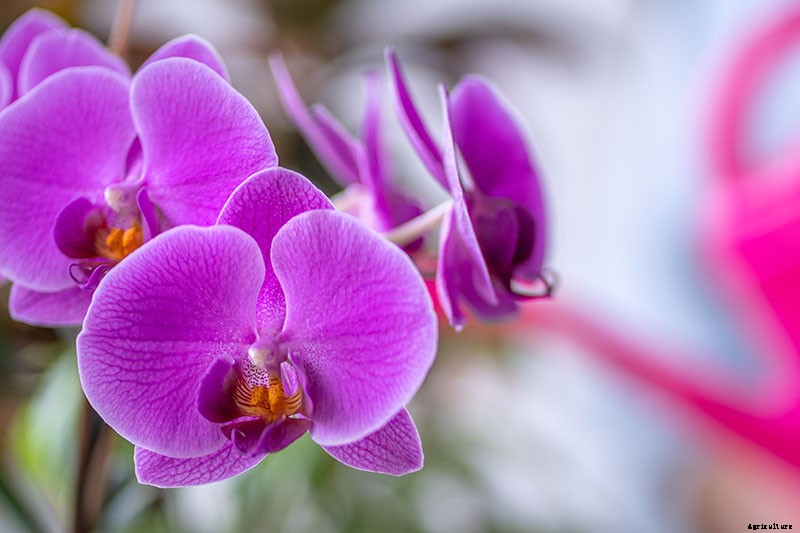
一方で、 あなたが陸生種を持っているなら、 あなたは完全に施肥をスキップしたいかもしれません。
「KewGardener’s Guide to Growing Orchids」では、 」 アマゾンで入手可能 、 著者のフィリップ・シートンは、陸生生物は本来の生息地の栄養素が自然に少ない状態で成長するため、陸生生物にまったく餌を与えないことを推奨しています。
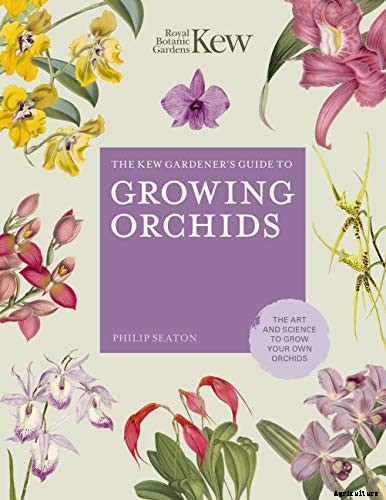
Kew Gardener’s Guide to Growing Orchids
個人的には、 私は自分の施肥レジメンをもう少し自然にするのが好きです、 なのでミミズの鋳物で作ったお茶をやさしく使っています 有益な微生物の追加ボーナスを持っている徐放性肥料。
ワーム堆肥を手元に用意していない場合は、 TeaDropsと呼ばれる便利なティーバッグで購入できます。
バッグをぬるま湯に4〜24時間浸してから、この調合液で植物に水をやります。
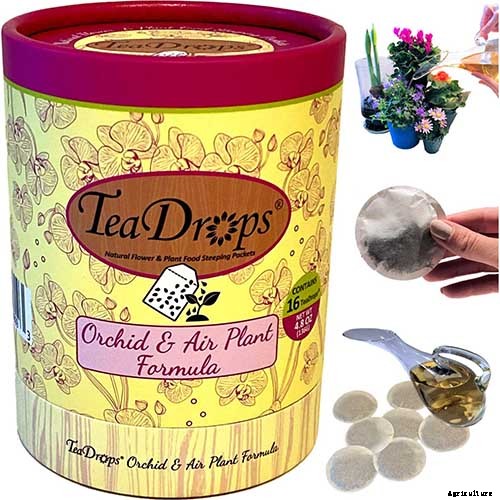
TeaDropsオーキッドとエアプラントフォーミュラ
TeaDropsOrchidとAirPlantFormulaは Earthworm Technologies available via Amazon 。
湿度
Most orchids do well in an environment with humidity levels between 40 and 70 percent 。
いつものように、 you’ll want to check the specific recommendations for your particular species or cultivar, which may be higher or lower than this range.
If you’re not sure what the humidity levels are in your home and you want to take your orchid growing seriously, you can use a gauge to monitor humidity levels.
I use the Goabroa digital humidity gauge, アマゾンで利用可能 。
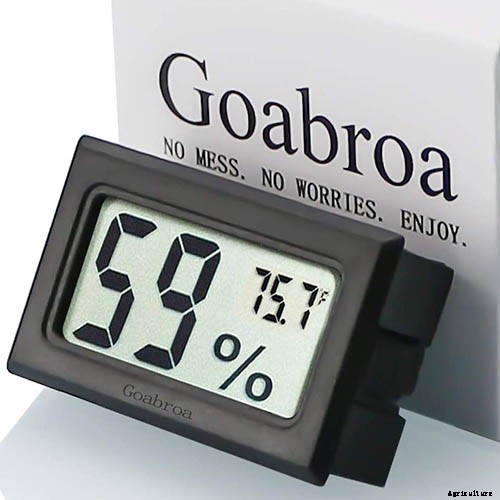
Goabroa Digital Humidity Gauge Monitor
In winter when the air is dry, or for those of us who live in an arid climate year-round, there are a few ways you can increase humidity for these plants:
- Use a humidifier to help humidify the air in your home.
- Group them together with other houseplants.
- Grow them inside a テラリウム 。
- Place them on a humidity tray.
A humidity tray is simply a waterproof tray lined with a layer of pebbles or gravel and filled with water.
The tray should be big enough to allow water to evaporate under the entire width of your plant.
Place plants on saucers before placing on the humidity tray to reduce any chance of letting their pots sit in water.
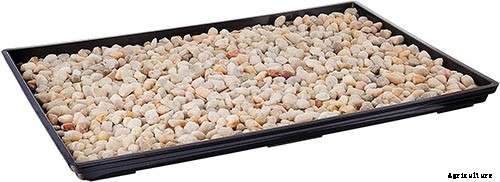
Brussel’s Bonsai Humidity Tray
This humidity tray from Brussel’s Bonsai is 13 inches long, made of black plastic, and it comes with pebbles to fill it up.これは アマゾンで利用可能 。
You can also find humidity trays that don’t require pebbles.
Some have a grid that fits snugly into the tray instead – you pour water into it, and it evaporates throughout the day, humidifying the air around your houseplants.
How much humidity is too much?
According to Greg Griffis and Peter Zale, PhD, at Longwood Gardens, if you see mist hanging in the air, it means the air is oversaturated and you should reduce your efforts to increase humidity.
And if you’re wondering if you should mist the leaves of your plant with a spray bottle, know that this is not the best method to provide your orchids with the humidity they need.
Misting can give you a false sense of security – if you are relying solely on misting to provide your plant with humidity, especially in a dry climate like mine, a once-a-day mist isn’t going to help much.
But the main problem with misting is that a wet orchid will be more likely to succumb to bacterial or fungal disease.
Water could drip down the leaves and pool in the crown of your plant, leading to crown rot 。
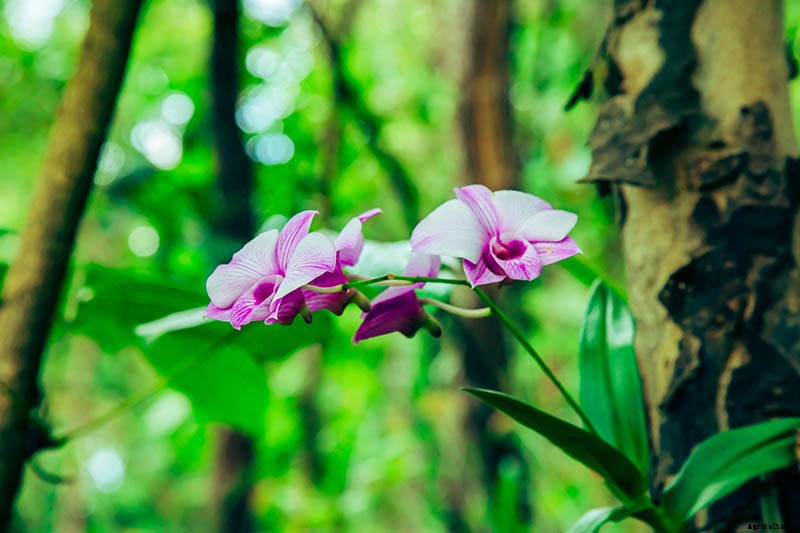
本来は、 many phalaenopsis species grow from trees hanging down or sideways to prevent water from pooling in their crowns.
Since we are growing them upright, we have to make sure we keep the crowns water-free.
Instead of misting, stick to the recommendations listed above for increasing humidity.
Air Movement
Going hand in hand with humidity, these plants also need good air movement. This is particularly important in more humid climates and seasons, or when growing in 温室 。
According to Linda Seals and colleagues at the University of Tennessee’s Agricultural Extension Service 、 air movement will help provide these plants with carbon dioxide, as well as reducing the risk of fungal or bacterial disease.
The more humid your environment, the more air movement is needed. And the inverse is also true – in drier climates or weather, aim for less air movement.
An overhead fan, or an oscillating floor fan directed away from the plants, will generally provide enough air movement.
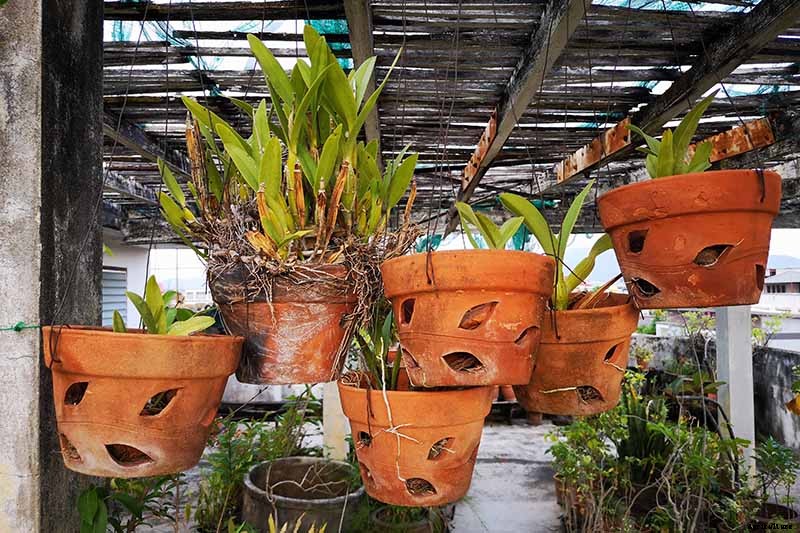
野生で、 many species grow with their roots exposed to the air, so air circulation is important not only for the foliage of these plants but also for their roots.
Using a special pot with side slits can help get air to the roots, and these provide better drainage as well.
You can learn more about the special containers used for growing these plants in our article on orchid pots. (( 近日公開 !)
成長のヒント
- Don’t grow orchids in regular potting soil, instead use a specially formulated growing medium.
- Water approximately once a week.
- Provide bright, 間接光。
メンテナンス
Maintenance includes keeping up with watering and fertilizing as discussed above, in addition to cleaning your plant’s leaves, coaxing flowers from your plant, and repotting regularly.
Clean Your Plant’s Leaves
Clean your plant’s leaves off with a moist rag on a regular basis to remove dust. Scheduling this maintenance for your weekly watering time is a good idea.
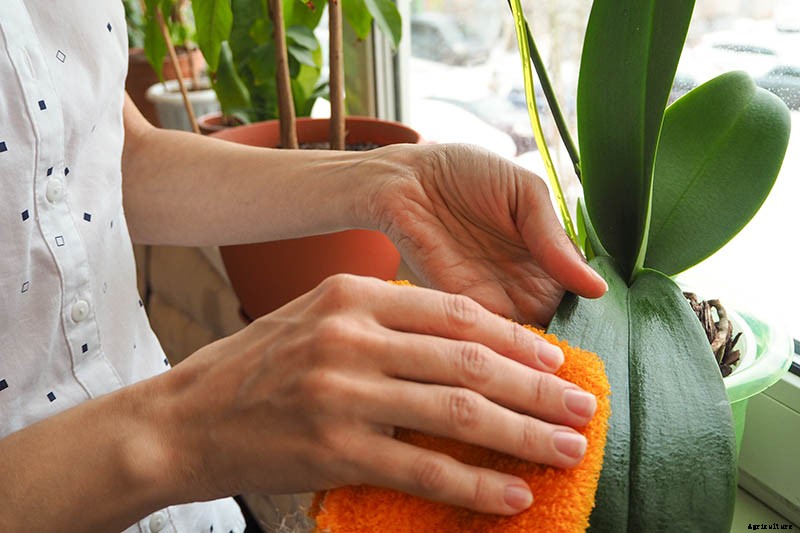
Cleaning your plant’s foliage regularly will help ward off insect pests and keep leaves healthy.
Make sure your rag is moist but not soaking wet – remember, you don’t want water pooling in the crown of your plant.
Encouraging Blooming
If you follow the care instructions described above, your plant should be more than willing to honor your home with its gorgeous flowers – and that’s the whole reason you bought it in the first place, 右?
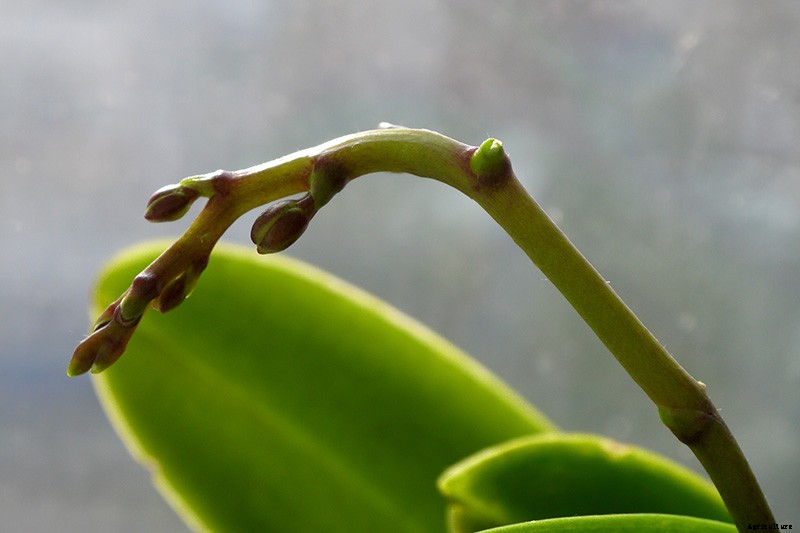
Providing your plant with adequate light, fertilizing it gently, and giving it the day/night temperature differential that it requires are your main responsibilities in encouraging your plant to bloom.
If it blooms from a long spike, as with phalaenopsis, you may need to stake it for support.
It’s a good idea to do this before the flower buds open up, to ensure that the extra weight of the flowers is supported. Gently insert a stake into your growing medium and attach the spike to it with a twist tie.
A specimen purchased with a flower spike will likely already be staked.
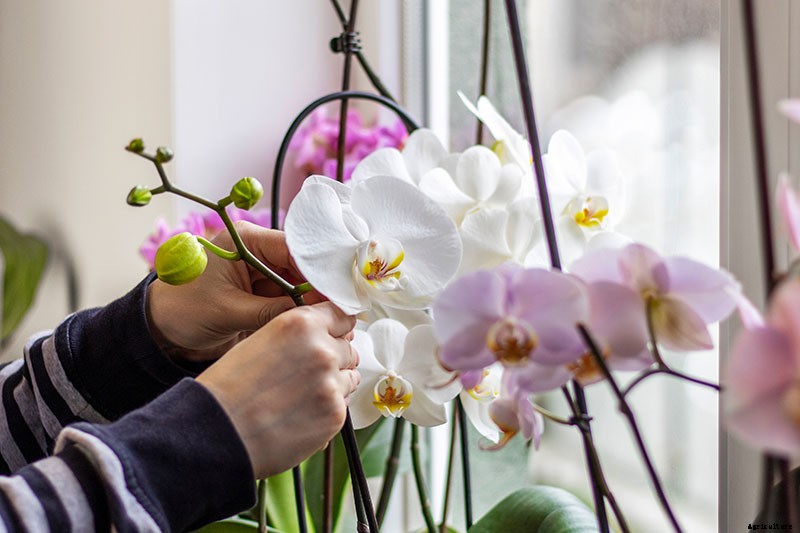
While many sources recommend trimming spikes on spent flowers, old spikes will sometimes rebloom year after year.
So while you get to know your new plant, you may want to leave the flower spike intact to see if your plant will bloom from old spikes.
Spikes that turn brown or yellow won’t rebloom and can be pruned. If you decide to trim your plant’s spent flower spike, make sure to use sterilized 剪定はさみ or scissors.
For phalaenopsis, trim the spike about an inch from the soil. For other genera, be sure to consult specific care information for your genus before pruning.
Read more about encouraging orchids to bloom in our article ( 近日公開 !)
Repotting
Forget everything you know about houseplants when it comes to repotting your orchids.
Orchids are not repotted to move them to a larger pot in most cases, but instead, to provide them with fresh growing medium.
Old growing medium can become compacted over time as it starts to break down, making it harder for your plant’s roots to get the air they need.
それが理由です、 even if your orchid doesn’t look like it needs to be repotted based on its size, you should still repot it on a regular schedule.
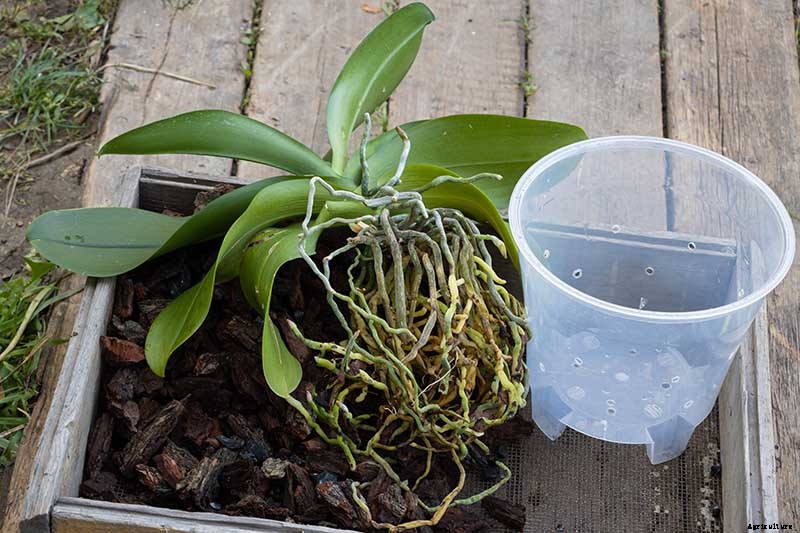
Repot your orchid every one to two years, in a pot that is only big enough to contain the plant’s roots. This may be the exact same pot, filled with new growing medium.
Or if your plant’s roots are growing a lot, move it to a pot that is one size bigger, but no more.
The period after your flowers have faded and when there is new root growth is a good time to repot.
You may also want to repot when you bring a new plant home to ensure it is growing in an appropriate potting medium, 上記のように。
To repot, remove the plant from its pot and gently loosen the roots to remove the old potting medium.
This may feel a bit counterintuitive if you are used to being careful not to overhandle plant roots while repotting houseplants or transplanting garden veggies.
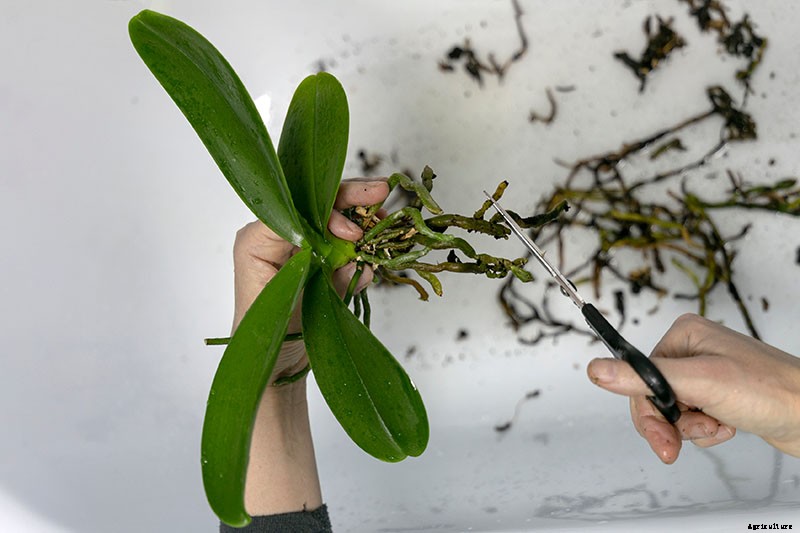
Trim unhealthy roots if needed, place roots into the new (or same) pot, and fill with fresh growing medium.
Some growers like to water right away, and others prefer to wait two or three days before watering. If you trimmed any rotten roots from your plant, wait a few days before watering.
Make a note of the date you repotted on your calendar, and then go ahead and schedule your plant’s next repotting appointment.
You might also place a sticker with your repotting date on the plant’s pot, また add a note in your gardening journal 。
For a full step-by-step guide to repotting your orchid, check out our guide. (( 近日公開 !)
選択する品種
Are you ready to try out one of these colorful houseplants?
Orchid flowers come in a huge array of hues, including whites, purples, ピンク、 赤、 oranges, yellows – even browns and 緑 – as well as striped, spotted, or harlequin patterns.
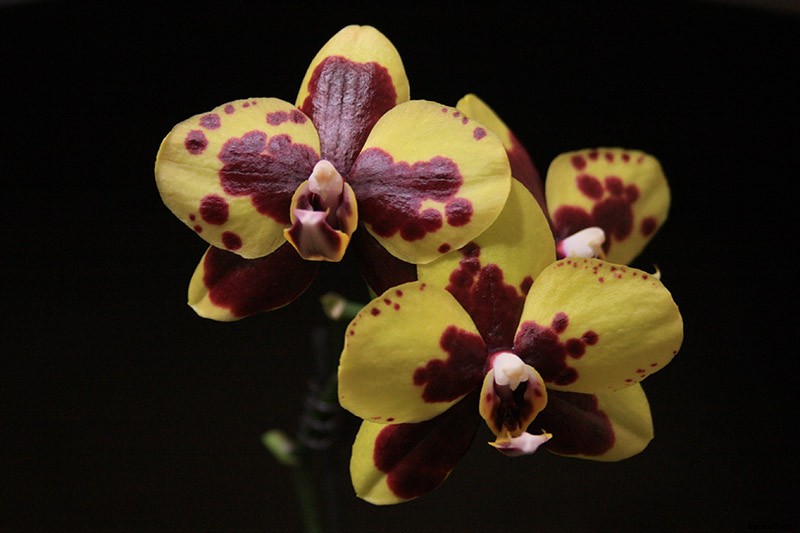
But before you choose a color, make sure you select a variety or species that will adapt well to the conditions you have available for it.
また、 when buying live plants, make sure to pick one that is “blooming size” if you’re impatient for flowers – or use this growing opportunity to cultivate your patience at the same time that you cultivate your orchid!
Cattleya
Cattleyas are known as corsage orchids due to their widespread use in the cut flower industry, beautifying prom goers and wedding ceremonies for decades. They are epiphytic or lithophytic and are native to the Americas.
These cultivars are considered easy to grow at home. They bloom in late winter or early spring and their blossoms can last for a month.
Cattleya flowers are large and showy, available in shades of white, 黄、 オレンジ、 赤、 ピンク、 紫の、 and green. Many of them are fragrant.
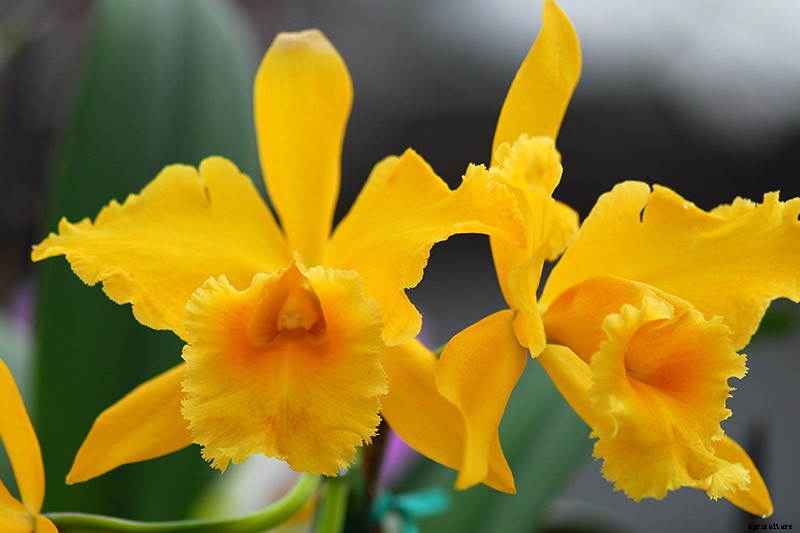
In order to produce flowers, cattleyas need nighttime temperatures that are 15-20 degrees cooler than daytime temps.
Cattleyas have a sympodial growth habit, producing pseudobulbs that help the plant store water.
They can be large, growing up to two feet tall, but there are some mini cattleyas that will fit nicely on your windowsill.
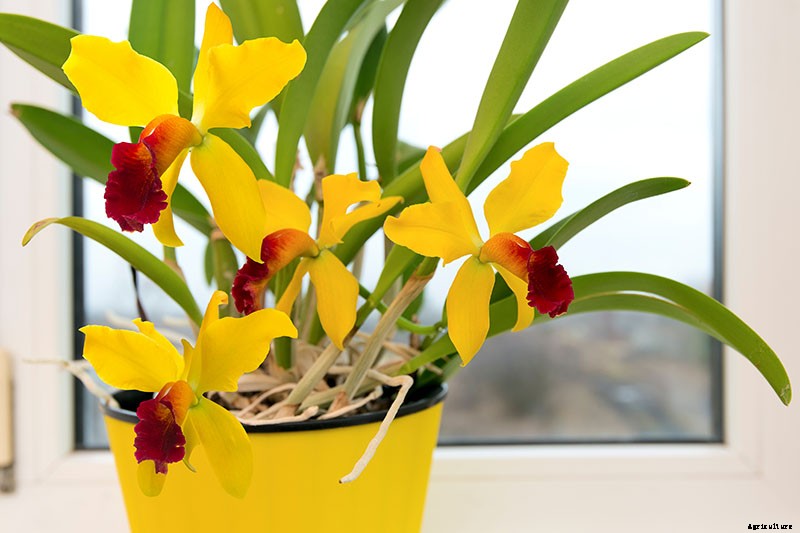
Cattleyas prefer daytime temperatures of 70-85°F and nighttime temps of 55-60°F. Humidity levels of 50 percent or higher are best.
The potting medium should have large particles to allow the roots to dry easily. Mature plants should be allowed to dry out between waterings.
Cattleyas prefer higher light – place them near a south-facing window where they are exposed to bright, 間接光。
Hsinying Mini Beauty
‘Hsinying Mini Beauty’ is an intergeneric hybrid with cattleya and rhyncholaelia ancestry.
It is considered a mini cattleya. This hybrid produces bright tricolored flowers that are magenta, 白い、 と黄色。
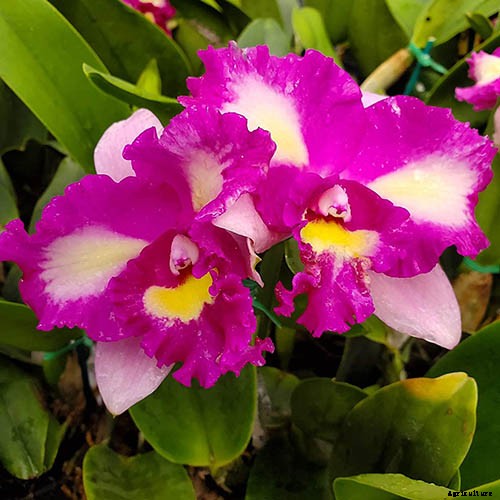
‘Hsingying Mini Beauty’
As a mini cattleya, this variety does well with medium light.
Kawamoto Orchids in Hawaii grows ‘Hsingying Mini Beauty’ clones from tissue.
You can purchase one of their blooming-sized plants in a five-inch container アマゾン経由 。
Dendrobium
Sometimes called “spray orchids, 」 Dendrobium is a genus that includes over 1, 800 different species. These are native to Asia and Oceania. Most of the species in this genus grow on trees or rocks.
The flowers come in shades of purple, ピンク、 白い、 黄、 オレンジ、 茶色、 and green, with the lip usually being a different color from the petals and sepals.
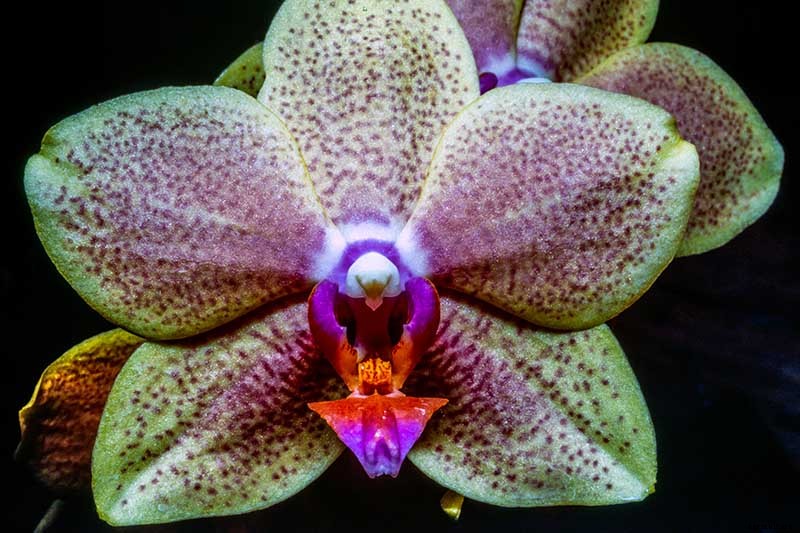
Dendrobiums are sympodial and usually have pseudobulbs. The pseudobulbs are upright and in some species are thin and cane-like.
The leaves of dendrobiums tend to be longer than they are wide and can be oblong, linear, or cylindrical. Dendrobiums can grow up to four feet tall and four feet wide.
Some are 落葉性 、 others are evergreen – and both types may require a dormant period in order to flower.
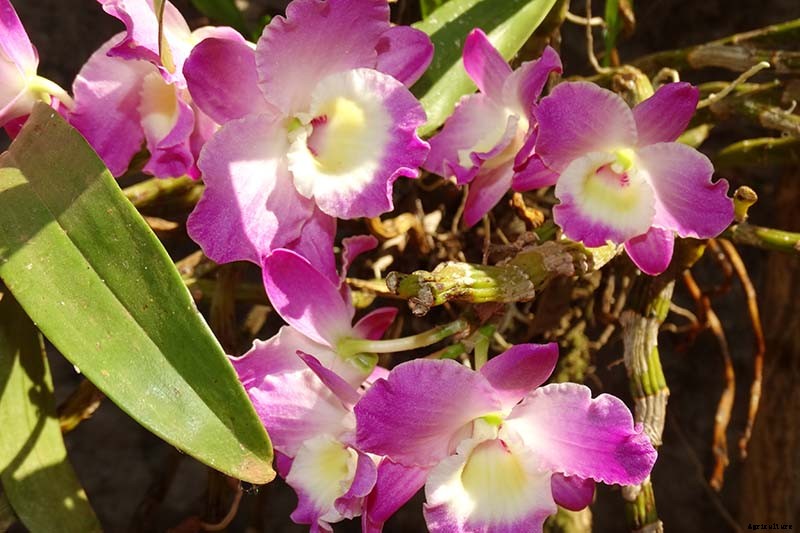
Dendrobiums do best with bright, indirect light and can be placed in a slightly shaded southern window.
They are warm growers, preferring daytime temperatures in the 80-90°F range and nights between 60 and 65°F.
Mature dendrobiums should be allowed to dry out between waterings. When repotting, keep in mind that they like to be in a tight pot. Dendrobiums have tall upright growth and can benefit from staking.
Dendrobium Hybrid
Sometimes new crosses don’t have names yet! Kawamoto Orchid Nursery in Hawaii is selling this cross between NS。 ‘Little Sweet Scent’ and D. anosmum ‘Stripe, ’ grown from seed.
Since this is a seedling plant and not a clone, it will be a new individual and its exact characteristics won’t be known until it blooms for you. The parent plants had highly fragrant lavender colored flowers.
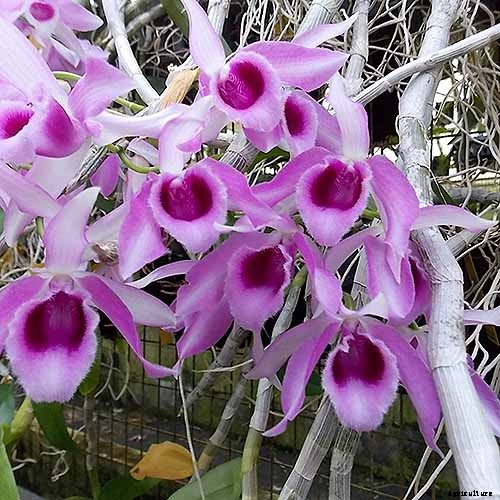
Dendrobium Hybrid
This is a deciduous type – its leaves will turn yellow and drop before it blooms.
This hybrid is available as a blooming-sized plant from Kawamoto Orchid Nursery via Amazon 。
Phalaenopsis
Phalaenopsis is a genus that includes about 70 different species.
“Phals” as they are commonly called, are generally considered the easiest orchids to grow at home. Also called “moth orchids, ” they are native to tropical Asia and Australia.
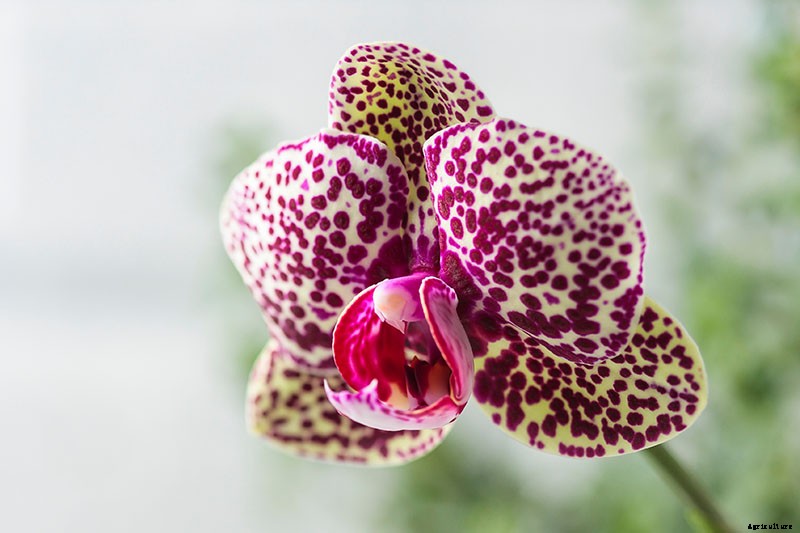
Phals bloom in winter from a flower spike with multiple blooms. Flower colors can be shades of white, 黄、 ピンク、 赤、 or salmon, and flowers sometimes have striped, harlequin, or spotted patterns.
Flowers on phals can be very long lasting – between three to five months. They need several weeks of temperatures between 55 and 60°F to encourage flowering.
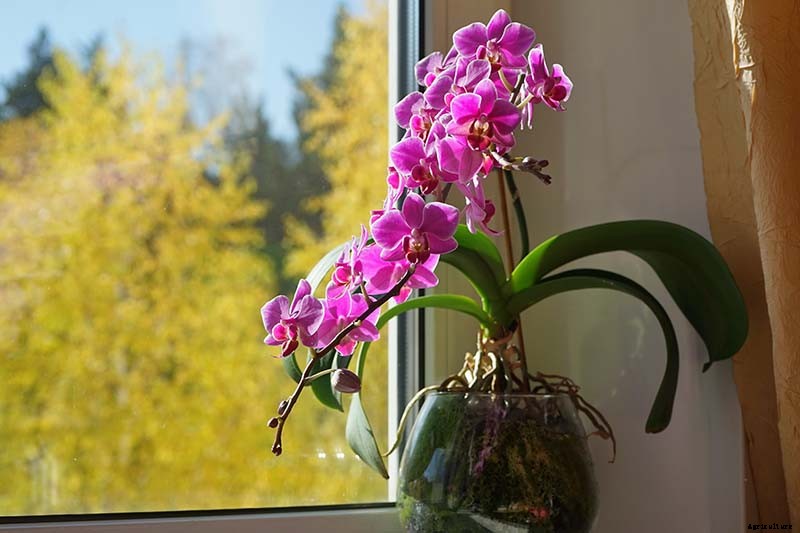
Phals have a monopodial growth habit, fleshy alternate leaves, and can grow up to three feet tall.
They do well in low or medium light, and can be placed on east-facing window sills or near a shady southern window. They are warm growers, tolerating daytime temperatures of up to 90°F.
Phals are considered great starter orchids because of their easygoing natures, adapting well to average indoor conditions.
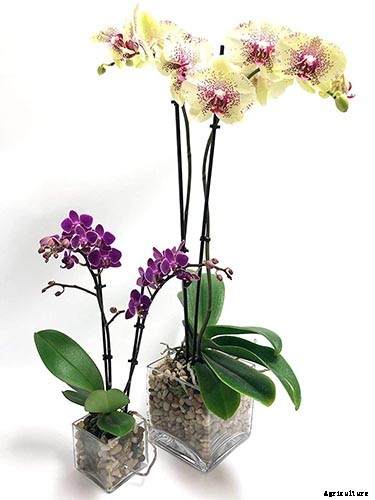
Phalaenopsis
You can find a set of two Phalaenopsis – one with purple flowers and the other with yellow blooms – grown in gravel from Athena’s Plants via Amazon 。
害虫や病気の管理
幸いなことに、 these plants aren’t highly prone to either pests or diseases, but when one of these appears, you’ll want to act fast to save your plant.
昆虫
Insects may be more of a problem when growing these plants in a greenhouse or when they spend summers outdoors.
しかし、 some insects can hitch a ride from the nursery where they were grown, so you’ll want to inspect new plants before you buy them or as soon as they arrive home.
Be on the lookout for アブラムシ 、 規模 、 コナカイガラムシ 、 と ハダニ 、 all of which will set up camp on your plant and suck out nutrients, interfering with the orchid’s ability to feed itself through photosynthesis.
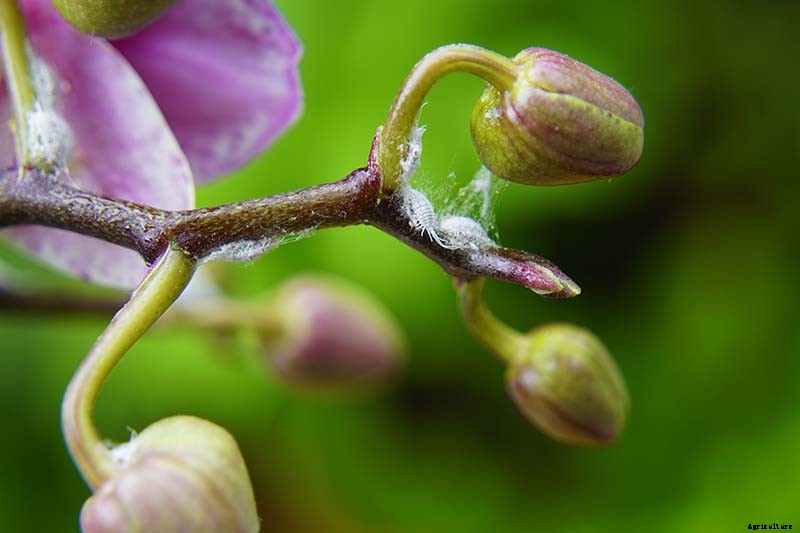
Washing the leaves on a regular basis will help prevent an infestation.
If infestations occur that are not manageable through leaf washing, neem oil can be used to kill pests without posing a health risk to your family or pets.
When using neem oil, follow the manufacturer’s recommendations for applying the product.
And keep in mind that neem oil shouldn’t be applied on very hot days, when plants are in full sun, or to cultivars with very thin leaves.
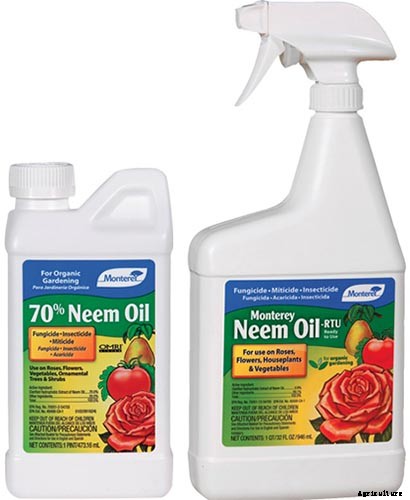
モントレーニームオイル
Monterey Neem Oil is an OMRI-listed product that is recommended for treating aphids, mites, scale, and mealybugs, among other pests.
You can find it in a 32-ounce spray bottle or as a concentrate in a pint-size container ArbicoOrganicsで 。
To learn more about keeping your plants insect free, check out our guide to common orchid pests. (( 近日公開 !)
疾患
With orchids, disease isn’t generally spread by insects in our homes or greenhouses – instead, 私達 are the main culprits, unwittingly transmitting disease with unsanitized hands or tools.
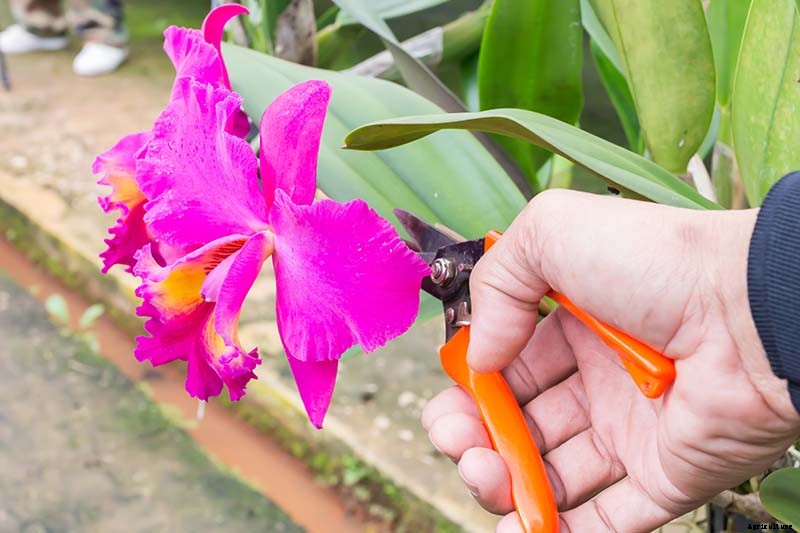
So disease prevention comes down to good hygiene practices – wash your hands between handling different plants, and sanitize your tools.
Sometimes infected plants show no signs of illness, so use good hygiene between handling different plants even if they seem healthy.
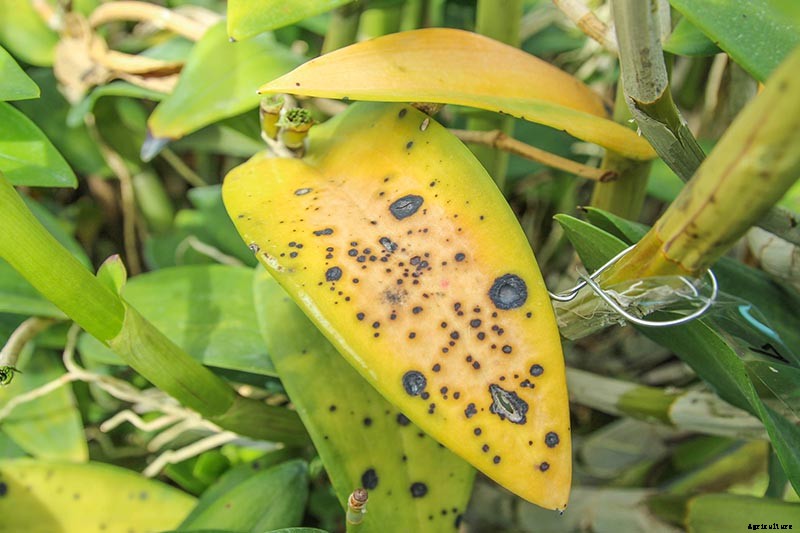
The two most common viruses to look out for are Cymbidium mosaic virus and Odontoglossum ringspot virus. There is no cure for either of these viruses, so prevention is imperative.
Learn more about these and other orchid diseases in our article. (( 近日公開 !)
クイックリファレンス成長ガイド
Plant Type:Flowering perennialsFlower Color:White, ピンク、 紫の、 赤、 黄、 オレンジ、 緑、 brown Native to:North America, 南アメリカ、 アフリカ、 ヨーロッパ、 アジア、 OceaniaMaintenance:Moderate Exposure:Bright indirect sunUses:Ornamental, houseplant, cut flower Water Needs:ModerateOrder:Asparagales Soil Type:Well draining soilless medium (orchid growing medium)Family:Orchidaceae Soil pH:5.0-6.5Subfamilies:Apostasiodideae, Cypripedioideae, Epidendroideae, Orchidoideae, Vanilloideae Soil Drainage:Very well-drainingGenera:Cattleya, Cymbidium, Dendrobium, Oncidium, Phalaenopsis, Vanda Common Pests:Aphids, fungus gnats, mealybugs, orchid blossom midges, scale, spider mites, アザミウマ、 whitefliesCommon Diseases:Black rot, botrytis, きゅうりモザイクウイルス、 Cymbidium mosaic virus, Odontoglossum ringspot virus, orchid fleck virus, Phyllosticta leaf-spot, potyviruses, tospoviruses
Take Care ‘Chids
Congratulations – you have successfully completed Orchids 101!
You now know all the essentials for taking good care of your orchid houseplant:provide it with a special growing medium instead of potting soil, go easy on the watering, only repot one size up at most, and give it indirect light instead of full blazing sunlight.
と、 unless you skipped to the end, you also know that there are many, many different types of orchids, and you should always adapt your care to your species or cultivar’s particular requirements.
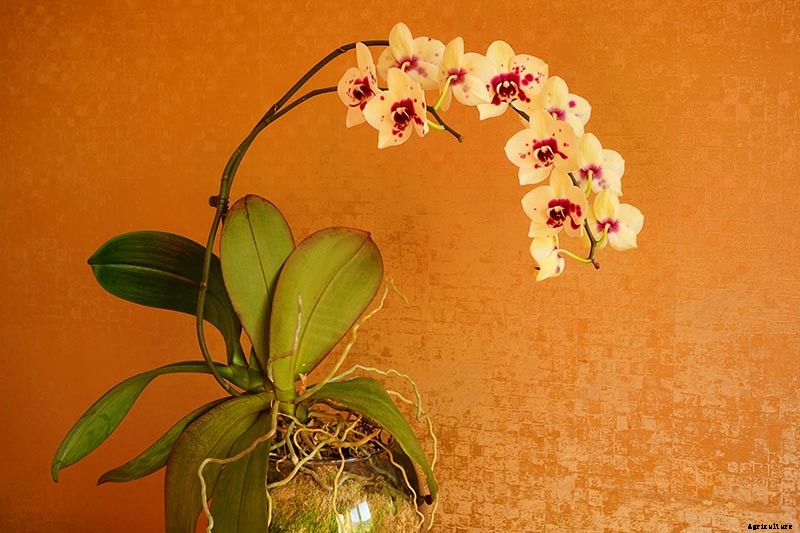
Are you thinking of bringing home one of these beauties for the first time? Or perhaps your previous attempts to grow them didn’t turn out so well, but you’re ready to try again.
Tell me your orchid growing story in the comments section below, I’d love to hear it!
If adding a green companion or two to your home puts a thrill in your heart, you might want to check out some of our other guides to growing houseplants 次:
- Grow Indoor Air Plants for Living Wall Art
- How to Grow and Care for Rubber Trees
- How to Grow and Care for Spider Plants
































































